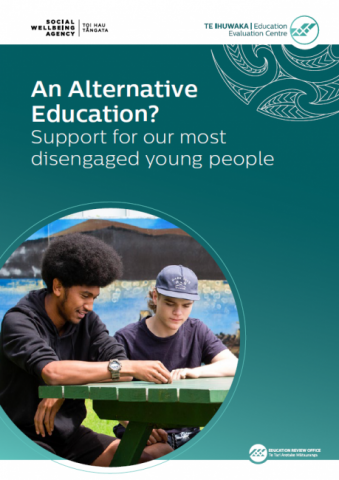Summary
Each year, Alternative Education provides education to over 2,000 young people who have been disengaged from education and who have high and complex needs. Many are exposed to crime, violence, and trauma, and just under a third have a mental health need. Almost two in five have been referred to Attendance Services.
The Education Review Office (ERO), in partnership with the Social Wellbeing Agency (SWA), looked at how well the education system is supporting young people in Alternative Education.
This study describes what we found and what is needed to significantly improve education for these young people.
Whole article:
An Alternative Education? Support for our most disengaged young peopleAcknowledgements
We acknowledge and thank all the young people, parents and whānau, educators, leaders and others who shared their experiences, views, and insights through interviews, group discussions, and surveys. We thank you for giving your time, and for sharing your knowledge and experiences so openly and whole-heartedly.
We also thank the key academics, and staff from the Ministry of Education, Oranga Tamariki, and other government agencies who participated in interviews and for their support in delivering this evaluation.
We want to acknowledge and thank the members of the Expert Advisory Group who shared their knowledge and wisdom in guiding this evaluation. The members were:
- Professor Ian Lambie ONZM, University of Auckland, Chief Science Advisor for the Justice Sector, New Zealand Government
- Dr Sonja Macfarlane FRSNZ, Associate Professor, Massey University
- Dr Julia Ioane, Associate Professor, Massey University
- Dr Adrian Schoone, Senior Lecturer, Auckland University of Technology
- Dr Nicola Atwool, independent consultant
- Tina Lomax, Principal, Kingslea School
- Pauline Melham, Senior Advisor, Whaikaha | Ministry of Disabled People
Executive summary
Each year, Alternative Education provides education to over 2,000 young people who have been disengaged from education and who have high and complex needs. Many are exposed to crime, violence, and trauma, and just under a third have a mental health need. Almost two in five have been referred to Attendance Services and one in four have been suspended.
The Education Review Office (ERO), in partnership with the Social Wellbeing Agency (SWA), has looked at how well the education system is supporting young people in Alternative Education.
This study describes what we found and what is needed to significantly improve education for these young people.
What is Alternative Education?
Alternative Education is an educational intervention provided to secondary school learners who are disengaged or alienated from school, and who are unlikely to be able to learn productively in school.
The aim of Alternative Education is to provide young people with a quality education and to support them into education, training, or work.
Young people in Alternative Education are taught by educators, who do not have to be registered teachers. They are taught in small groups, often with a ratio of one educator to around 10 young people. They are usually taught by one or two educators and do not have to rotate around classrooms. They are not usually on school grounds. They can be in community houses, youth facilities, or with tertiary training providers.
What does good education look like for these young people?
Quality teaching practices in Alternative Education recognise that many of the young people have experienced trauma and have a range of needs. To thrive in Alternative Education, young people need educators to address both their education needs and their broader needs.
Like all learners, young people in Alternative Education need quality teaching.
This evaluation looked at education provision for young people who attend Alternative Education. We answered three key questions:
- Who are the young people in Alternative Education and what are their outcomes and experiences?
- How good is Alternative Education provision?
- What changes are needed to strengthen provision?
Who are the young people in Alternative Education, and what are their outcomes and experiences?
Young people in Alternative Education are the most highly disengaged from education.
Many are exposed to crime, violence, and trauma, and just under a third have a mental health need. Many are in the Youth Justice system. They are 25 times more likely than other young people to have had a Family Group Conference.
Many are exposed to crime, violence, and trauma, and just under a third have a mental health need. Many are in the Youth Justice system. They are 25 times more likely than other young people to have had a Family Group Conference.
Almost one in three (31 percent) of young people in Alternative Education have been referred to a specialist mental health service. This is more than four times more likely than the rest of the population.
One in 12 (8 percent) of young people in Alternative Education have had a Family Group Conference in the Youth Justice system, 25 times more likely than the rest of the population.
Young people in Alternative Education have high involvement with Oranga Tamariki (OT). One in six (17 percent) of young people in Alternative Education have been in the care of Oranga Tamariki, nine times more likely than the rest of the population.
Young people in Alternative Education have high levels of transience - one in five (21 percent) have moved schools three or more times before starting at Alternative Education.
Young people in Alternative Education are disproportionately Māori and male, though providers reported the number of females has increased recently.
Seven out of 10 (68 percent) young people in Alternative Education are Māori, compared to 24 percent outside of Alternative Education.
Six out of 10 (63 percent) of young people in Alternative Education are male, compared to 51 percent outside of Alternative Education.
Young people are often referred to Alternative Education due to behaviour. Over a quarter have been suspended or excluded. They are also referred due to attendance issues, and alienation from school. Sometimes they are referred by Youth Justice or Oranga Tamariki.
Many young people in Alternative Education have been suspended or excluded. More than one in four (28 percent), have been suspended at least once, which is 22 times more likely than other young people.
Prior to starting in Alternative Education, two out of five (38 percent) young people in Alternative Education have been referred to Attendance Services. This is over five times more likely than the rest of the population.
These young people’s needs have not been identified and met early enough. They also have significant gaps in their learning, which have not been addressed.
Waiting for a place at Alternative Education deepens disengagement. This indicates that our education system is not currently set up with sufficient, or the right range of provision, to meet the needs of these young people.
In the year before they start attending Alternative Education, young people in Alternative Education miss an average of 58 days of school. Educators told us that many young people are working at a level several years below their age – for example, at Year 4 or 5 level (age 8 to 10), even though they are 13 to 16 years old.
While in Alternative Education, these young people attend more, enjoy learning more, and feel safer. They have stronger sense of belonging, and improved behaviour.
Fourteen of 22 whānau report their young person attends Alternative Education more than they attended their previous school. There is no national attendance data for young people in Alternative Education.
Three out of four (76 percent) young people in Alternative Education prefer it to their previous school.
Four out of five (84 percent) young people in Alternative Education have a tutor they like, and four out of five (83 percent) have someone who cares about them.
When they move out of Alternative Education, only around one in four return to school. More than half do not go on to further training or employment. By age 20, almost 70 percent are receiving benefits.
Only three in 10 (28 percent) young people who attend Alternative Education are attending tertiary education at age 18, and by age 24 this drops to one in 10 (11 percent).
At age 24, almost two-thirds (63 percent) of people who had attended Alternative Education were receiving a benefit, compared to half of adults (51 percent) with similar backgrounds, but who never went to Alternative Education (matched comparison group).
Alternative Education does not provide good outcomes. These young people have significantly worse outcomes than other young people, worse even than very similarly disengaged young people with high needs. They are very unlikely to achieve an education qualification. As adults, they are much more likely to be receiving benefits and be involved in the criminal justice system.
- At age 18, four in 10 (39 percent) of young people from Alternative Education have Police proceedings against them compared to 6 percent of other young people.
- Less than one in 10 young people from Alternative Education achieve NCEA Level 2 or higher (nine percent), compared to eight out of 10 other young people.
How good is Alternative Education provision?
The current model of Alternative Education is inadequate to meet the level of need of these often highly disengaged young people, leading to worse outcomes than for other young people:
- Teaching is weak and teaching resources are inadequate. Only one in five educators in Alternative Education are registered teachers.
- Facilities are often so run down they act as a barrier to learning. We visited 22 Alternative Education provision sites and found six operating out of poor-quality or inadequate facilities.
- Funding is inadequate. Budget 2023 recently allocated an additional $25.216 million over four years to Alternative Education, to increase the funding per place to $16,536 from January 2024. This is less than the funding for some small secondary schools.
- Funding limitations make it unviable for many providers, and provider and staff turnover is high.
- Providers are often isolated from other providers and schools, so they often lack access to broader education resources (e.g., careers advice, specialist subjects, sports) and professional teaching support.
- Providers cannot always access the broader wrap-around support young people need.
- Accountability for delivery and outcomes is weak.
When young people (exceptionally) do succeed at Alternative Education it is due to the elements of the model that do work:
- Small class sizes. Young people reported the smaller class size at Alternative Education was a critical element in their feeling safe and able to learn.
- Having the same educator throughout the day. We heard that getting to know their educators and be known by them meant young people felt cared for and supported.
- The flexibility to provide a different education on a site separate from school. Young people engaged enthusiastically when their learning was meaningful to them. Their poor experiences of school mean it is important that Alternative Education is different to school.
- Having staff with experience, aptitude, and commitment to working with these young people, who act as positive role models.
These elements need to be combined with a model enabling quality education, wrap-around support, and a range of pathways.
Alternative Education is potentially a missed opportunity to change these young people’s life trajectories.
They are often engaged and attending, but the current model of provision is failing to provide them with a quality education and may be contributing to poorer outcomes. The long-term costs for the young person, their family, and broader society are very significant.
What changes are needed to support provision?
This study has found that there is a group of young people who have high and often complex needs, and are highly disengaged or at high risk of disengaging from education. It has also found that we need to provide these young people with a better education. ERO recommends action across five areas.
Area 1: Better identify and meet the needs of these young people before they become disengaged, and increase the number who are able to stay and succeed in mainstream schooling. 1) The Ministry of Education provide guidance on how to effectively identify young people most at risk of disengagement, and support schools to better identify these young people. 2) Having identified young people most at risk of disengagement, the Ministry of Education support schools to act early to enable them to stay and succeed in school, including increasing awareness of:
3) ERO and the Ministry of Education identify and share with schools best practice in managing challenging behaviours in the classroom to enable more young people to stay in school. |
|---|
Area 2: Make sure there are a range of effective options (of different type, intensity, and duration) available for those young people who are not thriving in the school setting and that there are clear, consistent, and rigorous gateways so that young people are matched to provision that best meets their needs. 4) The Ministry of Education examine the range of options available for those young people who are not thriving in the school setting, how well they meet the range of needs and are complementary, and how clear and consistent the criteria for referral are. 5) To support decisions, made with whānau, on which education options are suitable for a young person, the Ministry of Education develop guidance for all schools that includes:
|
|---|
Area 3: As part of this set of options, reform the ‘Alternative Education’ model of provision so that there is a new model that is designed to meet both the education and broader needs of the most disengaged young people who need an alternative to mainstream schooling. 6) The Ministry of Education develop a clear national model and set of standards for high quality ‘Alternative Education’ provision that includes:
7) The Ministry of Education to ensure all current and future ‘Alternative Education’ provision has suitable premises and facilities – in line with the expectations for other learning environments. 8) The Ministry of Education supports teachers in ‘Alternative Education’ with a lead of professional practice, curriculum resources tailored for young people in ‘Alternative Education’, and facilitated professional networks. 9) The Ministry of Education, Ministry of Health, Oranga Tamariki, Whaikaha | Ministry of Disabled People and Ministry of Social Development work together to ensure young people in ‘Alternative Education’ are a priority for the specialist support they need. |
|---|
Area 4: Put in place the support needed for successful pathways and transitions from ‘Alternative Education’ into further education, training, or employment. 10) The Ministry of Education, Tertiary Education Commission, Ministry of Social Development, Whaikaha | Ministry of Disabled People, and Oranga Tamariki review the transition and ongoing support for young people in ‘Alternative Education’ to ensure young people have a planned and supported pathway, with sufficient pastoral and learning support, to make a successful transition into further learning or work. |
|---|
Area 5: Strengthen accountability and monitor how well provision is meeting the needs of young people who are in ‘Alternative Education.’ 11) The Ministry of Education actively monitor the quality of provision in ‘Alternative Education.’ 12) The Ministry of Education report annually on the education experiences and outcomes for young people in ‘Alternative Education,’ including:
13) The Ministry of Education ensure ‘Alternative Education’ providers and contract-holders collect and report reliable data on young people’s enrolment, education outcomes, and destinations. 14) The Ministry of Education reports back to the Minister of Education, and Ministers with responsibility for Oranga Tamariki and Youth Justice, on progress made in response to these recommendations by June 2024. |
|---|
Conclusion
Together these recommendations have the potential to significantly improve education experiences and outcomes for disengaged learners. Improving education for these young people can dramatically improve their lives and life course. It will take coordinated and focused work across the relevant agencies to take forward these recommendations and ensure change occurs. We recommend agencies report to Ministers on progress by June 2024.
About this report
Each year Alternative Education provides education to over 2,000 13 to 16 ‑year-olds who have been most disengaged from learning. Young people in Alternative Education have often experienced trauma and have had negative experiences of school.
Alternative Education aims to re-engage young people in education and support them back into education, training, or employment.
This report looks at how well Alternative Education provides a quality education for young people who have been disengaged from learning.
The Education Review Office (ERO) and the Social Wellbeing Agency (SWA) worked together to produce this report looking at how the education system supports young people in Alternative Education.
- ERO is responsible for reviewing and reporting on the performance of early learning services, kura, and schools. As part of this role, ERO looks at how the education system supports young people’s outcomes.
- The Social Wellbeing Agency is a multi-disciplinary team including data scientists, policy thinkers, researchers, evaluators, and communicators who work on challenging social sector problems to improve people’s lives.
We also worked closely with an Expert Advisory Group with a range of expertise, that included academics, educators, practitioners, and agency officials.
This report describes what we found about the quality of education and outcomes for young people in Alternative Education settings. It explores the reasons for young people’s outcomes, and suggests areas for action.
The voices of young people in Alternative Education, and their parents and whānau, are an important element of this report. We include their views on participating in Alternative Education, their learning and outcomes, and how the teaching practice in Alternative Education impacts on their learning and lives.
ERO last evaluated the quality of Alternative Education in 2011
Alternative Education is intended to re-engage young people who are the most disengaged from learning. Twelve years ago, we found that this was not happening. Schools were often not working well with Alternative Education providers. They were also not working well with young people and their families to help young people make positive transitions out of Alternative Education and into further education and employment.
Since then, the Ministry of Education has updated the legislation and guidelines for Alternative Education, under the Education and Training Act 2020 and the Alternative Education Guidelines in 2019 and 2022. Due to the timing of the changes to the Alternative Education guidelines, and when we collected data, the effects of the changes are yet to be seen and are not included in this report.
What we looked at
This evaluation looks at education provision for young people who attend Alternative Education. We answered three key questions:
- Who are the young people in Alternative Education and what are their outcomes and experiences?
- How good is Alternative Education provision?
- What changes are needed to strengthen provision?
This report focuses on the education provision for young people while in Alternative Education. The quality of provision in young people’s previous schools, and the pastoral support they received is an important contributor to their outcomes but is outside the scope of this study.
Where we looked
We focused our investigation on young people in Alternative Education, Alternative Education providers, Alternative Education contract holders and schools. To ensure we captured a range of experiences across a variety of learning contexts, ERO included Alternative Education providers across Aotearoa New Zealand; and a range of models of provision, including faith-based, school-based, kaupapa Māori, and others.
How we evaluated education provision
We have taken a robust, mixed method approach. To understand how good provision is for young people in Alternative Education, we used multiple sources of information, including:
- detailed analysis of administrative data in the Integrated Data Infrastructure
- site visits and observations of teaching and learning at 22 Alternative Education settings, managed by 11 different contract holding schools
- fifty-three interviews and 124 surveys of young people in Alternative Education
- nineteen interviews and 23 surveys with whānau of young people in Alternative Education
- sixty-five interviews and 65 surveys of leaders, tutors, and teachers at Alternative Education
- forty-four interviews and 126 surveys of school leaders
- analysis of documentation from agencies and providers
- interviews with key informants in the Alternative Education sector.
Analysing data in the Integrated Data Infrastructure
The Social Wellbeing Agency used the Integrated Data Infrastructure (IDI) in four ways:
- describing the characteristics, contexts, and prior experiences of 23,238 Alternative Education participants
- identifying a matched comparison group of similar young people who never participated in Alternative Education
- describing the future outcomes and activities (age 17 to 30) of people who previously participated in Alternative Education, compared to the matched comparison group and the overall population
- comparing the outcomes and activities for different groups of people who participated in Alternative Education.
Further details of the work ERO did can be found in Appendix 1. Full details of the work SWA did can be found in their technical report Experiences and outcomes of Alternative Education participants – An IDI analysis supporting an evaluation of Alternative Education.
Who is missing?
There is a group of young people who have disengaged from education, but have not made it to Alternative Education. Many of these young people are likely to be in the matched comparison group of young people.
There are also young people who are officially attending Alternative Education, but continue to be disengaged. We have not been able to talk to these young people, and so this report does not reflect their experiences, although their outcomes are included in the IDI analysis.
How this fits with other government work programmes
This report provides up-to-date information on the quality of provision for young people in Alternative Education and provides crucial insights to inform future redesigns and improvements to Alternative Education as part of Priority 6 within the Learning Support Action Plan 2019 ‑ 2020.1
Report structure
This report has 10 parts.
- Part 1 sets out what Alternative Education is and how it works.
- Part 2 describes the group of young people in Alternative Education.
- Part 3 sets out what good quality provision looks like in Alternative Education.
- Part 4 shares our findings about the education experiences for young people.
- Part 5 shares the outcomes for young people from Alternative Education.
- Part 6 explores the differences and similarities in experiences for different groups of young people in Alternative Education:
- Māori young people
- Pacific young people
- female, male, and other genders
- young people in Oranga Tamariki care
- disabled young people
- very young learners in Alternative Education.
- Part 7 explains why the outcomes for young people in Alternative Education are so poor.
- Part 8 describes what enables success, for the few who experience it.
- Part 9 shares our key findings and areas for action.
- Part 10 sets out the next steps to drive improvement for young people in Alternative Education.
Part 1. What is Alternative Education and how does it work?
The aim of Alternative Education is to provide young people with a quality education and support them back into education, training, or work. Young people are taught by educators, in small groups, often off school grounds.
In this section, we describe what Alternative Education is, how it is organised, and how the decision is made for a young person to attend Alternative Education.
What is Alternative Education?
Alternative Education is an educational intervention provided to young people who are disengaged or alienated from school and who are unlikely to be able to learn productively in school.
The objective of Alternative Education is to provide young people with a quality education and support them back into education, training, or work.
Young people can enter Alternative Education between Years 9 and 11 (around 13 to 16 years old) and can stay in Alternative Education until Year 13 (up to 19 years old).
There are 1,888 funded places and each year over 2,000 young people attend, about 1 percent of all learners. Young people can attend Alternative Education anywhere from three weeks to over three years.
How is Alternative Education different from school?
Young people in Alternative Education are taught by educators, who do not have to be registered teachers. They are taught in small groups, with a ratio of one educator for around 10 young people. Unlike secondary school learners, they do not have to rotate around classrooms; they are usually taught by one or two educators.
There is also more flexibility in Alternative Education. Young people might not attend every day and might not learn the New Zealand Curriculum. Instead, they have a plan that sets out their goals and the steps they are taking to achieve those goals.
Alternative Education providers also work with the young person and their family to overcome barriers to education, which may include non-educational barriers; for example, providing clothing and transport, or working towards more stable living circumstances.
The sites look different too. As there are fewer young people on each site, facilities are a lot smaller and are typically not specifically designed as learning environments. While some providers operate out of classrooms on school sites, many are out in the community, in community houses, youth facilities, or with tertiary training providers.
How is Alternative Education organised?
Alternative Education is a contracted service model, with each area of the country having a set number of funded places. The Ministry of Education funds a contract holder, typically a school, who then manages the contracts with one or more providers of Alternative Education. Providers sometimes sub-contract elements of provision to other specialist providers.
Young people who attend Alternative Education must be enrolled in a school, however they do not have to be enrolled at the school that holds the contract. They can be enrolled in any local school. Appendix 2 sets out the roles and responsibilities of:
- Te Tāhuhu o te Mātauranga | The Ministry of Education
- contract holders – typically schools
- the school the young person is enrolled in
- Alternative Education providers.
There are several different models of provision including the:
- consortium model, where one or a few contract holders work together to run Alternative Education in their area.
- school-based model, where a school hosts Alternative Education on their school site.
- community-based model, where Alternative Education happens at a site in the community.
- Activity Centre and Alternative Education combined model, where an Activity Centre and Alternative Education provider work together.Activity Centres provide educational and pastoral support to students in Years 9 to 13 who are at risk of disengaging or poor outcomes. They have registered teachers who support students to increase their achievement and engagement in education.
How is Alternative Education funded?
The Ministry of Education contracts for and funds 1,888 places of Alternative Education each year. The current number of places is allocated across 86 contract holders.
At least 90 percent of the funding goes to the Alternative Education provider. Contract holders may retain up to 10 percent to cover the costs associated with managing the contract.
Providers use the funding for renting premises, paying staff, utilities, purchasing resources, and other incidental costs. Alternative Education providers often seek additional funding from other sources, such as charitable grants.
While the young people are attending Alternative Education, the school they are enrolled in does not receive operational funding for the young person. However, they are expected to:
- continue to provide specialist support that the young person was receiving while at school
- provide access to specialist services (e.g., behavioural support, learning support)
- allow the young people to participate in extra-curricular activities, including cultural and sporting opportunities.
Who is accountable for Alternative Education?
There is no single point of accountability in Alternative Education.
- The Ministry of Education is responsible for all enrolled students having access to full-time education.2
- The Ministry of Education is responsible for managing the contract with the contract holder.
- The contract holder is responsible for managing the contracts with the providers.
- The school the young person is enrolled in is responsible for ensuring learner outcomes.3
Who decides who attends Alternative Education?
What are the access criteria?
To access Alternative Education a young person needs to be at risk of or already disengaged from school, and either:
- in Years 9 to 11
- aged 13, but not yet Year 9, at the request of the young person and their whānau, and at the discretion of the provider and the Ministry of Education.
A young person can remain in Alternative Education beyond Year 11 if this aligns with their individual needs and their learning plan.
How is the decision made?
The young person, their whānau, or their school can all request Alternative Education. An Oranga Tamariki social worker or a judge can also request Alternative Education if the young person is in care or has an education related bail condition from the Youth Court.
The decision to allow the young person to attend Alternative Education is made by the contract holder.
Often the young person is put on a waitlist until a place becomes available. Young people can enrol in Te Aho o Te Kura Pounamu | The Correspondence School or apply for a home-schooling exemption while they wait for a place to become available.
Conclusion
Alternative Education is an educational intervention provided to young people aged 13 to 19 who are disengaged from learning at school. There is no single point of accountability. The Ministry of Education funds contract holders, often schools, to contract providers of Alternative Education, who can sub-contract to other providers. Young people and their whānau, their school, or an Oranga Tamariki social worker can request Alternative Education, but there is often a waitlist and the young person must find other options while they wait for a place to become available.
Part 2. Who are the young people in Alternative Education?
Young people in Alternative Education are highly disengaged from education and have high, and often complex, needs. Many are exposed to crime, violence and trauma, and just under a third have a mental health need. They are also some of the most disengaged from education, with two in five having been referred to attendance services.
They are disproportionately Māori and male, though providers reported the number of females has increased recently.
This section sets out characteristics of the young people in Alternative Education, their wellbeing needs, offending history, and education history.
We used the Integrated Data Infrastructure (IDI) to look at young people attending Alternative Education who were born between 1990 and 2005. We also looked at:
- data from the Ministry of Education about who has attended Alternative Education
- our interviews with young people, whānau, educators, Alternative Education providers, contract holders and school leaders
- survey responses.
This chapter sets out the demographic characteristics, needs, and life experiences of young people in Alternative Education, including their:
- ethnicity, gender, and age
- additional needs, including disability, exposure to violence and crime, material wellbeing and stability, as well as mental health history
- offending history
- education history, including behaviour, attendance and learning.
It then describes the key factors that make it more likely a young person will enrol in Alternative Education.
The following statistics describe negative experiences and outcomes for this group of young people, but these figures are not reflective of their worth. Young people in Alternative Education are resilient and resourceful, and many overcome the barriers of trauma and instability they experience at home and at school. Not all young people in Alternative Education have these negative experiences or outcomes.
What we found: an overview
Young people in Alternative Education are disproportionately Māori and male. Seven in 10 young people in Alternative Education are Māori, and six in 10 are male. Most are 15 or older, but the number of younger students is growing.
Young people in Alternative Education have high and complex needs. Many have exposure to violence and trauma in their families. One in six young people in Alternative Education have been in care.
Many have had interactions with the Youth Justice system. Nearly one in 10 have had a Youth Justice Family Group Conference, which is 25 times more likely than the rest of the population.
Young people in Alternative Education have a history of behaviour, attendance and learning problems. Over a quarter of young people in Alternative Education have been suspended or excluded at least once. Two in five have been referred to attendance services. Due to their prior absenteeism, suspensions, and exclusions, young people in Alternative Education have large gaps in their learning.
1. Ethnicity, gender, and age
Ethnicity and gender
Seven out of 10 young people in Alternative Education are Māori and six out of 10 are male.
Seven out of 10 (68 percent) young people in Alternative Education are Māori. Seventeen percent are Pacific, and 50 percent identify as Pākehā/ NZ European. This compares to 24 percent Māori, 12 percent Pacific, and 72 percent Pākehā/ NZ European in the general school population. (Young people often identify as multiple ethnicities, and so total ethnicity percentages add to more than 100.)
Figure 1: Ethnicity: Alternative Education participants and the rest of the population
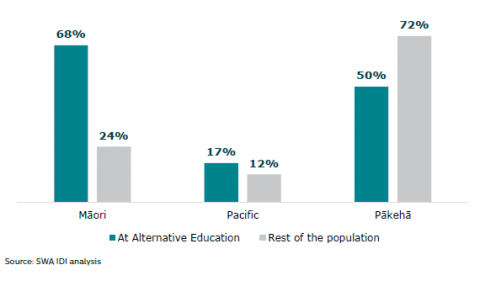
Source: SWA IDI analysis
Six out of 10 (63 percent) young people in Alternative Education are male, compared to five out of 10 outside of Alternative Education. In our interviews, providers told us the number of females enrolling in Alternative Education is increasing since the pandemic, and that some young people in Alternative Education identify as gender-diverse.
Figure 2: Gender: Alternative Education participants (The ability to identify gender diverse groups in the IDI is limited)
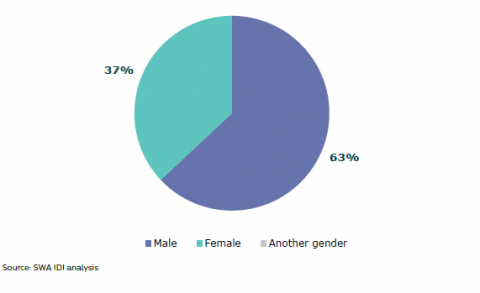
Source: SWA IDI analysis
Age
Most young people in Alternative Education are 15 or older, but around 8 percent first attend Alternative Education at just 13 years old.
Using data from young people who were born between 1990 and 2005, we looked at the age of young people when they first attended Alternative Education (some young people have more than one period of attendance at Alternative Education). Eight percent of young people were 13 years when they first attended Alternative Education. A third (33 percent) began at 14 years old, almost half (44 percent) began at 15 years old, and 15 percent were 16 or over when they first attended.
Providers told us they have noticed a trend towards more younger learners entering Alternative Education.
From 2023, young people can continue in Alternative Education up until Year 13, around 19 years old. Consequently, providers told us they expect more 16-year-olds and older attending in future.
Figure 3: Age of first attending Alternative Education
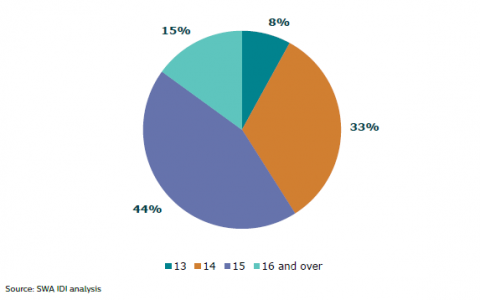
Source: SWA IDI analysis
2. Additional needs
Disability
How we measured disability
We counted someone as disabled if the IDI showed:
- the young person reported having at least one common activity on the WGSS they could only do with a lot of difficulty or not at all
- the young person has a diagnosis of ADHD or has had a prescription for ADHD medication
- the young person has a diagnosis of ASD
- the young person has a diagnosis of intellectual disability.
One in 10 young people in Alternative Education have an ADHD diagnosis.
Disabled learners are young people with significant needs who may require ongoing support, adaptations, or accommodations to thrive in education. (This definition is consistent with the New Zealand Disability Strategy and the United Nations Convention of the Rights of Persons with Disabilities. It is based on the social model of disability which defines disability as something that happened when people with impairments face barriers in society. The NZ Disability Strategy recognises that not all members of their community identify with this definition, and it is their right to choose the terminology they prefer.)
Young people in Alternative Education are more likely to have a diagnosis consistent with neurodivergence. (The Ministry of Education’s Learning Support Action Plan 2019-2025 describes neurodiversity as “a broad term that includes (but is not limited to) dyspraxia, dyscalculia, dysgraphia, autism spectrum disorder, foetal alcohol spectrum disorder, attention deficit/hyperactivity disorder, trauma related disorders, and auditory or visual processing disorders”. Co-morbidity, where a person has more than one diagnosis, is common.) The IDI shows that young people in Alternative Education are three times more likely than the general population to be diagnosed with ADHD. Ten percent of young people born between 1990 and 2005 who attended Alternative Education have ADHD, 1 percent have Autism Spectrum Disorder (ASD), 2 percent have an intellectual disability, and 4 percent have functional impairments identified through the Washington Group Short-Set (WGSS). Some young people may have more than one diagnosis. (The data on disabled young people in Alternative Education is likely to be an underestimation, as we only use what is recorded in the IDI.)
All the groups of people we talked to (including whānau, providers, contract-holding schools, and key informants) told us that a high number of young people in Alternative Education had undiagnosed learning disabilities such as neurodivergence, dyslexia, or dyscalculia.
Figure 4: Disabilities of Alternative Education participants, and the general population
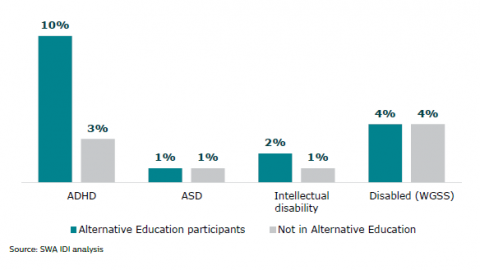
Source: SWA IDI analysis
“I’ve got ADHD and anxiety… I couldn’t concentrate, I couldn’t do anything [at school].” - Neurodivergent young person attending Alternative Education
“My family, we’ve had a lot of problems… They didn’t understand my disorders, they didn’t understand how to deal with me.” - Neurodivergent young person attending Alternative Education
“[younger son] he has ADHD, he wasn’t getting much help there. He was like going and staying in the toilets instead of going into class. He didn’t really like class.” - Parent of young person attending Alternative Education
Exposure to crime, violence, and trauma
Young people in Alternative Education are more likely to be living in families under stress due to violence and offending.
The parents of young people in Alternative Education have high rates of criminal offending; 10 percent of mothers, and 37 percent of fathers of young people in Alternative Education have had a custodial sentence at some point in the young person’s life.
Note: We mainly identified the parents of young people in our sample through the parents listed on the birth certificate of the young person (using alternative sources only where the young person did not have a New Zealand birth record). These fields are ‘parent 1’ and ‘parent 2’, and allow for the possibility that both listed parents are of the same gender. However, in our sample, almost all (very close to 100% of) people identified as ‘parent 1’ were female and almost all people identified as ‘parent 2’ were male. To acknowledge the strong gender differences in many of the aspects we are measuring (such as income and criminal justice experience), we report parent 1 as the mother and parent 2 as the father.
Figure 5: Parents who have served a custodial sentence: Alternative Education participants and young people not in Alternative Education
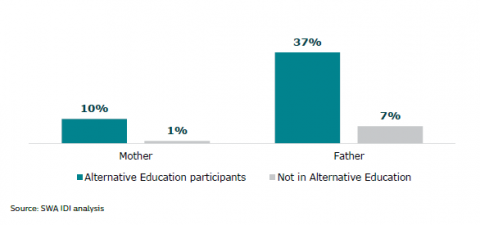
Source: SWA IDI analysis
At some point during their lives, young people in Alternative Education are:
- five times more likely than other young people to have a mother who has committed a violent offence and four times more likely to have a father who has committed a violent offence
- eight times more likely than other young people to have a mother who has been in prison, and five times more likely to have a father who has been in prison.
Young people in Alternative Education have high involvement with Oranga Tamariki.
One in six (17 percent) of young people in Alternative Education have been in care. They are four times more likely than other young people to have ever had a report of concern and nine times more likely to have ever been placed in care.
Figure 6: Involvement with Oranga Tamariki: Alternative Education participants and young people not in Alternative Education
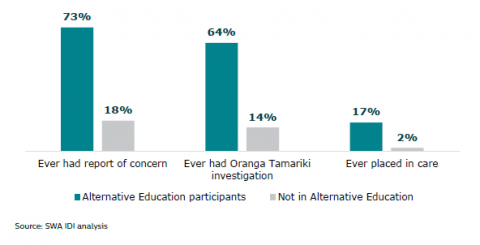
Source: SWA IDI analysis
“Primary school was about the time my nan died, and my mum was in and out of jail, so that really affected my school life, and I wasn’t doing really good.” - Young person attending Alternative Education
Material wellbeing and stability
Parents of young people in Alternative Education earn less than parents of other young people.
The income of mothers of young people in Alternative Education is one third less than mothers of other young people, and their fathers’ income is approximately half of other fathers. Their parents are around three and a half times more likely than the parents of other young people to rely on social welfare income.
Figure 7: Parents’ average income: Alternative Education participants and young people not in Alternative Education
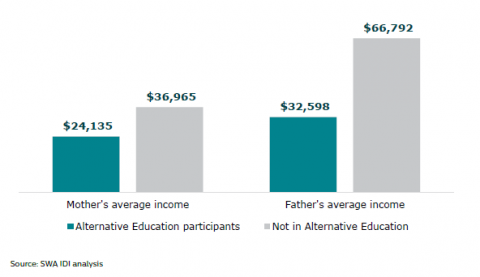
Source: SWA IDI analysis
Young people in Alternative Education are almost three times more likely to come from the most socio-economically deprived areas - 37 percent of Alternative Education participants come from the most deprived areas, compared to 13 percent of the rest of the population.
We heard in our interviews that young people in Alternative Education often live in poverty and economic hardship. Many providers we visited send food home with young people. For some young people, this is their only regular source of food. Most providers offer support with clothing, stationery, and bus passes.
“Growing up wasn’t the best. It was a bit rocky in my family, but we got there. I was around gangs my whole life, and violence, drinking, drugs.” - Young person attending Alternative Education
“Okay, so we have students who turn up regularly. No shoes … no food, dad’s just beat them up. That's not like that happens once a term that's like that happens three times a week.” - Alternative Education Educator
Parents of young people in Alternative Education are less likely to have qualifications.
Young people in Alternative Education are more than twice as likely as other young people to have a mother with no recorded qualifications (35 percent of fathers, and 29 percent of mothers have no recorded qualification).
Figure 8: Parents without qualifications: Alternative Education participants and young people not in Alternative Education
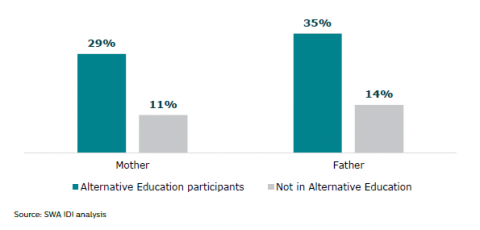
Source: SWA IDI analysis
Young people in Alternative Education have high levels of transience – one in five have moved schools more than three times before starting at Alternative Education.
Young people in Alternative Education are twice as likely as other young people to have moved home more than five times before they entered Alternative Education (46 percent of Alternative Education participants, compared to 23 percent of those not in Alternative Education). One in five have moved school more than three times (outside of the regular moves from one level of school to the next). They are five times more likely than other young people to have changed schools three or more times. In interviews, we heard that some young people are in transitional or emergency accommodation, or move around between family and friends.
Figure 9: School moves: Alternative Education participants and young people not in Alternative Education (Excluding moves between primary and intermediate school, and between intermediate and secondary school)
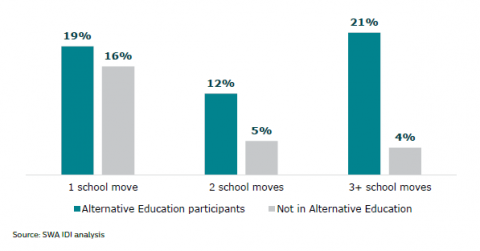
Source: SWA IDI analysis
Mental health needs
Almost a third have been referred to a specialist mental health service.
Nearly a third (31 percent) of young people in Alternative Education have been referred for a mental health need. They are more than four times more likely than other young people to have high mental health needs. The actual proportion with mental health needs is likely to be higher. We heard from many young people, whānau, and educators about young peoples’ undiagnosed experiences of anxiety and depression.
Figure 10: Mental health needs: Alternative Education participants and young people not in Alternative Education
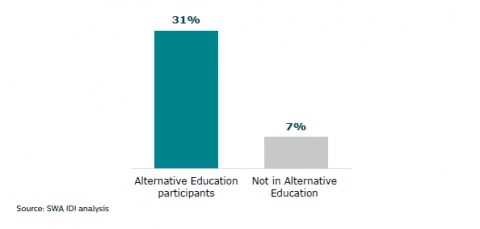
Source: SWA IDI analysis
“I’ve been through a bit of stuff throughout my life, and... hasn’t been easy, but I’ve... found good methods for myself… I’ve been through counselling and all of that, I’ve been on medication.” - Young person attending Alternative Education
| Young person attending Alternative Education because of their anxiety |
Kayla is a 15-year-old girl. She loved music at school, and enjoys playing her guitar. Kayla enjoyed primary school, but started to feel anxious at intermediate school. She started to skip school, eventually missing extended periods of learning. By the time she started secondary school, the large classrooms and noisy environments made her anxiety worse and she refused to attend. Kayla attended Te Kura and was at home for a year, but found it hard to keep herself motivated and focused through the online learning. She disengaged from learning completely for almost a year. Kayla’s mother is a primary school teacher. She heard about Alternative Education from a colleague and got in touch with the Alternative Education provider to check if Kayla would meet the criteria for enrolment. After meeting with the provider, Kayla’s mother worked with the provider and Kayla’s school to get her enrolled and attending Alternative Education. |
3. Offending history
Eight percent of young people in Alternative Education have had a Youth Justice Family Group Conference.
Young people in Alternative Education are 25 times more likely to have had a Youth Justice Family Group Conference. Nealry one in 10 (8 percent) of young people in Alternative Education have had a Youth Justice Family Group Conference, compared to 0.32 percent of other young people. Youth justice Family Group Conferences (YJ FGCs) are held when young people are alleged to have offended or once the charges have been proven. These are convened and facilitated by Youth Justice Coordinators. Most youth offending is dealt with without the need for a Youth Justice Family Group Conference. Young people whose offending is serious enough to warrant a Family Group Conference are at a higher risk of future offending, especially when accompanied by a Youth Court appearance or referral by Police to Oranga Tamariki to consider an application for care and protection in the Family Court.
Figure 11: Have had a Youth Justice Family Group Conference: Alternative Education participants and young people not in Alternative Education
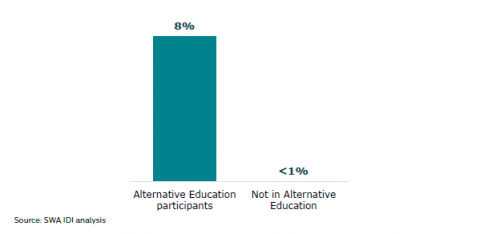
Source: SWA IDI analysis
“I made a silly decision and brang (sic) some drugs to school.” - Young person attending Alternative Education
“These students often come with trauma, learning needs and other complex needs. Sixty percent of the students come with Police involvement, and some of them remain in the justice system even after school.” - Alternative Education provider
4. Education history
Behaviour
Many young people in Alternative Education have been suspended or excluded – over a quarter (28 percent) have been suspended or excluded at least once.
Young people in Alternative Education have high standdowns, suspensions, and exclusions. Compared to young people not in Alternative Education, young people in Alternative Education are:
- ten times more likely to have at least one standdown
- twenty-two times more likely to have at least one suspension or exclusion.
Figure 12: Suspensions or exclusions: Alternative Education participants and young people not in Alternative Education
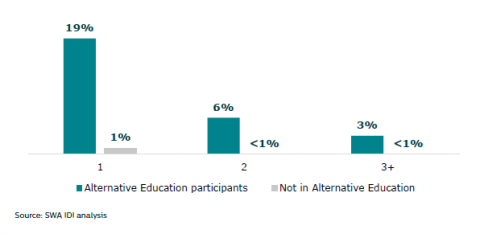
Source: SWA IDI analysis
Four out of five schools request Alternative Education for a young person due to behavioural issues.
We asked schools what the underlying issues were that led to the school requesting Alternative Education for young people in the last 12 months.
- Over half (52 percent) said they needed to remove a young person from the school and almost half (45 percent) said there was no other option for the young person.
- Four out of five (83 percent) schools said that Alternative Education better suited the young person because of their behavioural needs.
- Other reasons were because Alternative Education better suited the young person’s learning needs (52 percent) and social needs (48 percent).
“I just stuck up for myself. I just said what I had to say. If I was like an angry mood, I would take it out on them, and I would like want to fight them. So, like, yeah, and then that led to me getting kicked out.” - Young person attending Alternative Education
“[it’s] the demonstration of trauma actually, and, you know, it's that flight or fight stuff. Those kids are going to fight.” - Alternative Education educator
| Young person attending Alternative Education because of behaviour related exclusion from school |
Tane is a 15-year-old boy, currently attending Alternative Education. He lenjoys spending time with his friends at the skatepark. His primary school experience was not ideal as he went back and forth between two different schools. He now lives with whānau who have gang affiliations. Tane is known to the Police and has been in the Youth Justice system since primary school. Even though he enjoyed business studies and cooking at school, he found other subjects at high school hard. His behaviour went downhill from Year 9, and he was excluded from school in Year 10 as a result of repeated drug- and alcohol-related suspensions. Tane must attend Alternative Education that is not located on a school site because of the trespass notice he has been issued by his school board. |
Attendance
Prior to starting in Alternative Education, two out of five (39 percent) young people in Alternative Education have been referred to Attendance Services.
This is over five times more likely than other young people.
Figure 13: Number of Attendance Service referrals: Alternative Education participants and young people not in Alternative Education
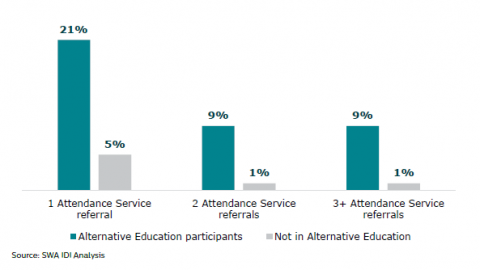
Source: SWA IDI Analysis
In the year before young people enrol at Alternative Education, they miss an average of 58 days of school and spend four times as long absent from school for unjustified reasons.
Figure 14: Justified and unjustified absence rates: Alternative Education participants and young people not in Alternative Education
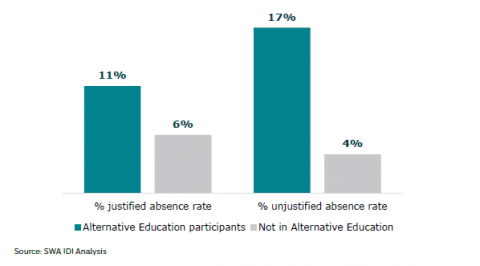
Note: Attendance rates are measured in Term 2. Attendance rate data is only available for some birth cohorts (1999-2005).
Source: SWA IDI Analysis
In interviews, young people told us they struggled at school and stopped attending, which made them too anxious to come back and face the work they had missed.
“I struggled a lot in school, and it would make me anxious to come to school, and so I would miss out on a whole bunch of work, and so when I would come back there would be work I need to catch up on that would freak me out more.” - Young person attending Alternative Education
Learning
Educators told us that some young people are years behind other people their age.
Absenteeism, standdowns, and suspensions or exclusions, together with disengagement means that there are significant gaps in learning for young people in Alternative Education. Educators told us that many young people are working at a level several years below their age – for example, a Year 4 or 5 level (ages eight to 10), even though they are 13 to 16 years old.
“These young people come to college with poor attendance from primary. They missed out on learning in primary.” - Contract-holding school principal
“More students with complex needs have continued to come to our doorstep. Once again, it highlights how Alternative Education is still the catch-all for students with severe learning, mental health and behavioural needs.” - Alternative Education provider
Risk factors that make it likely a young person will enrol in Alternative Education
There are a number of risk factors that indicate a young person may be more likely to attend Alternative Education.
- Young people with at least one prior standdown are 10 times more likely to enter Alternative Education than young people with no standdowns.
- Young people who have been suspended once are 18 times more likely to enter Alternative Education than those who have not been suspended.
- Young people who have been referred to the Attendance Service twice are nine times more likely to enter Alternative Education than those who have never been referred.
- Young people who have been reported as of concern to Oranga Tamariki are four times more likely to enter Alternative Education than those who have not been reported.
Just because young people experience these risk factors, it does not mean they are destined to go to Alternative Education. There are also a variety of protective factors, like having someone at school that cares about the young person, that help young people stay attending and engaged in education, and support them to succeed.
Conclusion
The young people in Alternative Education are some of the most disengaged young people from education in Aotearoa New Zealand, with complex needs. They are more likely than other young people to have mental health needs, be exposed to trauma and violence, more likely to live in financial hardship, and less likely to have stable homes. They have complex needs and a history of offending. They are very disengaged from school and have substantial learning gaps when they start at Alternative Education.
Part 3: What sort of education provision drives good outcomes for these young people?
Our evaluation is informed by the best evidence about what leads to education success for young people in Alternative Education. We carried out an extensive review of New Zealand-led and international literature on what effective practice looks like for young people who are alienated from school and have complex needs. This section sets out how this evidence base informed our evaluation.
What we did
To understand what quality provision looks like in Alternative Education settings, we:
- carried out an extensive review of Aotearoa New Zealand and international literature on best practice
- worked with an Expert Advisory Group of people with experience working with young people who are disengaged from learning, academics, and agency officials to identify key components of quality provision
- considered the National Education and Learning Priorities, which apply to all learners in Aotearoa New Zealand, and priority six of the Learning Support Action Plan (2019-2025).
We have identified three components of quality provision:
- Addressing barriers to learning
- Re-engaging in learning
- Appropriate teaching (pedagogy) and meaningful curriculum
We have also identified six components that are required to deliver on the quality provision:
- Positive, nurturing relationships and environments
- Collaboration for effective transitions and pathways
- Effective leadership and ongoing improvement
- Workforce capacity and capability
- Culturally responsive practice
- Agencies working together
For each component we used the literature evidence base to define what good looks like. We then used these indicators of good practice to guide us in making judgments about the quality of provision and practice for young people in Alternative Education. The indicators of good practice we used are in Appendix 3.
What are the components of effective practice?
1. Addressing barriers to learning
Quality teaching practices in Alternative Education recognise that many young people in Alternative Education have experienced trauma 4,5 and have a range of complex needs. They may also need intervention to stop criminal activity (e.g., to protect against anti-social peers and pro-crime attitudes).
Complex needs can be barriers to learning in any educational setting and can impact on their future education or vocational pathways.6 Meeting young people’s mental health, behavioural, and social needs is positively associated with increased employment, increased job satisfaction, and reduced criminality.7,8
Education settings for young people with complex needs have been successful when they employ a ‘joined-up, wrap-around’ support approach,9 to respond well to the complex range of challenges faced by these young people. A holistic approach to supporting Māori young people’s success is also essential.10, 11
While maintaining a focus on education, Alternative Education providers need to play a role in addressing broader need. Good practice in Alternative Education supports the young people and their whānau to address their barriers to learning in three ways.
- Working with other social agencies that are addressing the young person’s additional needs and any offending history.
- Providing a safe environment for learning that is culturally responsive, recognises and responds to trauma, and is appropriate for neurodivergent young people.
- Teaching young people skills and strategies to manage their behaviour in classroom settings.
2. Re-engaging in learning
Young people often enter Alternative Education disengaged from learning and alienated from school. Alternative Education practice should improve young people’s engagement and enjoyment of learning and improve their attendance. ERO’s research on attendance found that education providers can help engage young people by creating a positive environment, promoting positive relationships between teachers and young people, and getting young people interested in what they are learning.12, 13
Alternative Education providers that do well in re-engaging young people in learning:
- create a sense of belonging in the programme
- build strong relationships between staff and young people
- have programmes of learning that are interesting to the young people
- help young people build pathways back to school, further education, or employment.
3. Appropriate teaching (pedagogy) and meaningful curriculum
While young people in Alternative Education need educators to use practices that are trauma‑informed, culturally responsive and recognise risk factors for offending, the fundamentals of good teaching practice are the same as for all young people.
Educators need to provide a meaningful, responsive curriculum, which engages and progresses young people’s learning from when they first arrive in Alternative Education. They also need to understand young people’s interests and where the young people are at with their learning. Teaching strategies should be evidence-based, targeted to the young person, and provide extra support or challenge.14
Aotearoa New Zealand research highlights that these specialised practices should be woven with appropriate culturally responsive approaches to teaching and learning, which are mana-enhancing and address the holistic needs of Māori young people.15, 16, 17, 18
Good practice in Alternative Education means giving young people a high-quality education by:
- offering young people access to the full breadth of the curriculum, and aligning teaching to the young people’s interests
- using effective teaching strategies, including evidence-based teaching practice and assessments
- having culturally responsive teaching practices for Māori.
What underpins the components of quality practice?
1. Positive, nurturing relationships and environments
To help re-engage young people in learning, the literature strongly emphasises the importance of a positive, nurturing learning environment for young people who have complex needs.19, 20 A positive environment creates a sense of belonging and of cultural identity or mana ōrite.21, 22
Trauma-informed classroom environments are calm, predictable, and have space for the young person to regulate their emotions. Their educators can regulate their own emotions, and respect and value the young person.23
Strong, learning-focused partnerships are well-known to be key to effective educational outcomes for learners, in any setting. Evidence shows a clear correlation between parent/whānau engagement and accelerated learning progress.24 For Māori children, this is particularly important.25 Successful learning partnerships give whānau an opportunity to share their aspirations for learning, share solutions, and to be informed of their child’s learning progress and successes.
Good practice in Alternative Education recognises that to re-engage in education and keep young people attending and participating, young people must feel safe and respected, and feel their educators care about getting things right for them. Having positive relationships with friends, and someone trusted to talk to at their Alternative Education provider is important.
2. Collaboration for effective transitions and pathways
Transitioning into a new learning context can be a stressful, destabilising experience for any student.26, 27 For young people in Alternative Education, this transition can be delayed, with the young people spending time on waitlists, increasing their disengagement from learning.
Good transitions are as smooth as possible and give young people in these settings the confidence they need to engage in learning. Evidence shows that creating a sense of belonging, tailored planning involving all aspects of the learning and development needs of the young person, and trusting relationships are key to successful transitions into Alternative Education and re‑engagement in learning.28, 29, 30
Good practice in Alternative Education includes a managed transition into the programme, with information that follows the young person. The first experiences of the young person enrolling in Alternative Education needs to be positive.
Research shows that young people leaving Alternative Education require ongoing support. Planning for transition out of Alternative Education should be included in the initial planning document for the young person when starting in Alternative Education.31 Plans need to include the next step for the young person, and the additional support they may need to continue to be engaged in learning.32
Transitioning out of Alternative Education is equally important, and good practice involves having a clear pathway and sharing of information between the Alternative Education provider and the education or employment the young person is transitioning to. Transitions should include a plan for ongoing support, including from whānau, from other social service providers, and from educational experts.33
3. Effective leadership and ongoing improvement
Leadership has a high level of influence over processes, practices, and effectiveness.34, 35 In Alternative Education, strong and consistent leadership is essential. It is pivotal that leaders understand the key components of education provision and respond to the specific needs of their young people. Qualified and committed leadership can improve outcomes for young people in Alternative Education.31 Leaders also play an important role in liaising across numerous groups and agencies.36, 37
Accountability is an important part of an effective model. There needs to be someone who is accountable for ensuring the model is working. That includes collecting and reporting on the outcomes young people attending Alternative Education are achieving, and taking an improvement-focused approach to the systemic barriers to their achievement and how to resolve them.
Good practice in Alternative Education means leadership that:
- has high expectations for young people, and works with their staff, the young people and their whānau on shared goals
- puts in place policies and processes that support young people to succeed, keeps the young people safe, and creates a positive nurturing environment
- has relationships that enable young people to get the support that they need.
4. Workforce capacity and capability
In order to bring out young people’s potential, staff need specialised expertise in understanding and responding to the educational barriers faced by young people with the most complex needs. Young people in Alternative Education often have acute wellbeing needs, offending histories, and learning needs. Fostering their educational success requires a high level of specialist pedagogical capacity and capability. The following aspects have been identified as important.
- Capability to work across a broad range of curriculum areas and learning levels.
- The ability to support skill development and learning across multiple domains (e.g., around the key competencies, along with social, psychological, cultural, and range of the curriculum).
- Good knowledge about the use of assessment tools and their application to teaching for young people in Alternative Education.
- Capability to adapt and tailor their teaching to the individual needs of the young people.
- Educators with high expectations for young people’s success so that their practice. supports young people with the resources and opportunities to realise their potential
- Commitment to young people38
- Cultural competency of educators, providers, and Alternative Education leaders.
- Knowledge and use of trauma-informed educational approaches and practice39
- Knowledge of identifying and working well with neurodivergent young people and their families40
- Ability to work effectively as part of a multi-disciplinary team often involving multiple agencies.
- Stable workforce.9
To respond well to the complexities of educating young people in Alternative Education, it is crucial for teachers to have access to the professional support and learning they need.
5. Culturally responsive practice
Māori young people make up 68 percent of young people in Alternative Education. Working closely with whānau, mana whenua, and iwi Māori is vital to ensuring Alternative Education is culturally responsive and meets the needs of Māori young people.41, 42 Well‑established relationships and partnerships with whānau, hapū, and iwi are necessary to enable good, culturally responsive practice to be embedded in Alternative Education.
6. Agencies working together
The literature consistently identifies that agencies working together effectively, from multiple disciplines, is key to promoting educational effectiveness for young people with high or complex needs.43, 44, 45 For these young people, educational success is affected by how different agencies work together.
In Alternative Education, this means having a system that believes in the education potential of these young people, and an education and social system that works together to support them to achieve that potential.
Conclusion
Best practice in Alternative Education means providing young people the high-quality education they are entitled to, addressing their barriers to learning, and helping them to re-engage with learning. This requires an effective transition into Alternative Education, a positive environment while they are there, and an effective transition out. Enabling this is effective leadership in providers and schools, a system that works well together, and an effective model to guide it.
Part 4: What are the experiences for young people in Alternative Education in Aotearoa New Zealand?
Young people have positive experiences in Alternative Education. They attend more, enjoy learning more, feel safer, have a stronger sense of belonging than at their previous school, and show improved behaviour. They have goals for their learning and discuss their progress with their educators.
This section describes young people’s experiences of participating and learning in Alternative Education, including their attendance and engagement in learning; sense of belonging and wellbeing; behaviour; and progress in learning.
How we gathered this information
The findings in this section are based on:
- interviews with young people, parents and whānau, educators, and contract-holding school leaders
- surveys of young people, parents and whānau, educators, and contract-holding school leaders
- site visits and observations.
What we looked at
To understand the experiences and outcomes for young people in Alternative Education, we looked at:
- attendance and engagement
- sense of belonging and wellbeing
- behaviour
- progress in learning.
Where possible, we asked how this compares to their experiences at their previous school.
What we found: An overview
Young people have improved attendance and engagement at Alternative Education. They attend more and have a more positive attitude to attendance. Fourteen of 22 whānau report their young person’s attendance improved. Nearly two thirds think going to school is important or very important. Three-quarters of young people prefer Alternative Education to their previous school.
Young people feel safer at Alternative Education and have a strong sense of belonging. Four out of five have someone who cares about them at Alternative Education, and almost all feel safe. Four out of five never, or almost never, feel lonely at Alternative Education.
Alternative Education helps young people improve their behaviour. Two thirds of young people are learning what to do when they get stressed. Thirteen out of 22 whānau, and nearly three‑quarters of schools young people in Alternative Education are enrolled at, see young people’s behaviour improve when they return.
Young people have goals in Alternative Education. Nearly nine out of 10 young people talk about their goals regularly with their educators. Four out of five young people think their work at Alternative Education is at the right level for them.
1. Attendance and engagement
Almost two-thirds of young people in Alternative Education think going to school is important or very important.
ERO’s attendance research found that, for secondary school learners, seeing school as important for their future was a major driver of attendance. The majority of young people in Alternative Education (61 percent) think school is important or very important – only 11 percent feel it is not that important/not important at all.
Three-quarters of young people in Alternative Education prefer it to their previous school.
Three quarters (76 percent) of young people in Alternative Education prefer to learn in Alternative Education. Fourteen percent prefer to learn in their old school.
Two thirds (67 percent) enjoy learning at Alternative Education, compared to less than a third (29 percent) who enjoyed learning at their old school.
Figure 15: Where young people prefer to learn
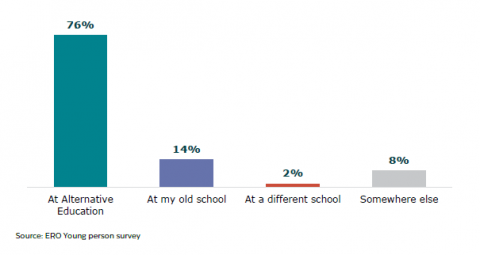
Source: ERO Young person survey
Almost all (97 percent) young people are helped by their educator when they need it, compared to less than half (44 percent) at their old school.
Figure 16: Young people who get help from educators at Alternative Education compared to at their old school
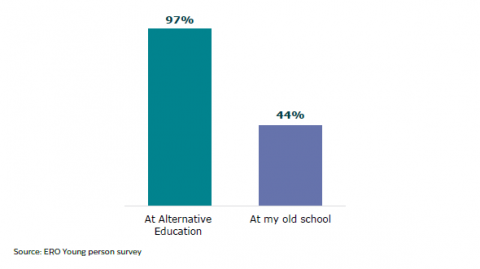
Source: ERO Young person survey
Young people have a better attitude towards attendance at Alternative Education.
In our interviews, whānau told us that their young person has better attendance and a better attitude to attendance while at Alternative Education. Providers told us that they support young people to attend by helping with transport, for example, a pickup service or tickets for public transport. Almost two-thirds (62 percent), of schools who have young people enrolled in Alternative Education report young people that return from Alternative Education have improved attendance.
Fourteen of 22 whānau report their young person attends Alternative Education more than they attended their previous school.
Young people in Alternative Education attend less regularly than young people who are still in school. However, there is an improvement to their attendance compared to their attendance at their old school. Fourteen out of the 22 whānau said that their young person has better attendance at Alternative Education.
“[in response to current attendance] Oh awesome! Yeah she gets up, gets ready and goes off and it’s been a big change.”- Parent of young person attending Alternative Education
“My attendance was like three percent at school, and here it’s like over 80.” - Young person enrolled at Alternative Education
2. Sense of belonging and wellbeing
Four out of five young people in Alternative Education have an educator they like and four out of five have someone who cares about them.
Most young people in Alternative Education feel a strong sense of belonging. Most have an educator they like (84 percent). Four out of five (83 percent)have someone who cares about them.
Figure 17: Young people who have an educator they like at Alternative Education compared to their old school
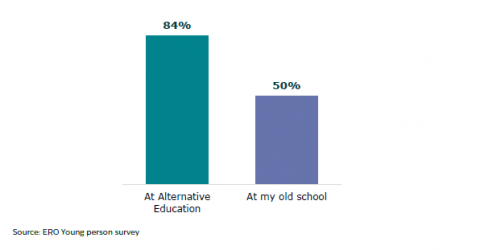
Source: ERO Young person survey
In interviews, young people told us that the positive experiences they had were due to the whānau-like structure of Alternative Education, as well as getting to know their educators and being known by them.
“They write about how this is the first place where I felt like I belong and, like, somebody cares. And that sense of belonging is, I think, what makes [Alternative Education] work… that it has to be a place where they feel like they belong and that they matter and that they're a part of something.” - Alternative Education Educator
“Here it’s small, I can actually ask for help and interact with all the tutors.” - Young person enrolled at Alternative Education
Young people feel safe in Alternative Education.
Young people’s sense of wellbeing is positive in Alternative Education, particularly:
- young people told us they feel safe at Alternative Education (93 percent)
- almost nine in 10 feel that their culture is respected (87 percent) in Alternative Education.
In our interviews, young people told us they feel secure, and confident that if any issues arose, they would be dealt with swiftly and fairly.
Figure 18: Young people who feel safe at Alternative Education compared to at their old school
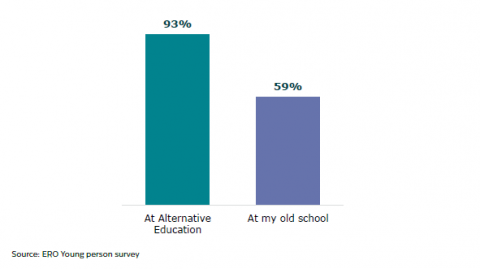
Source: ERO Young person survey
“I was getting harassed, bullied, body shamed…and I would tell the school but nothing got done.” - Young person attending Alternative Education
“Ākonga (learners) feel safe there, it is their tūrangawaewae (place to stand).” - Alternative Education counsellor
Young people feel less lonely at Alternative Education than at their previous school.
Four out of five (81 percent) young people never, or almost never, feel lonely at Alternative Education. Just under half (44 percent) report that was not the case at their old school.
Figure 19: Young people who never, or almost never, feel lonely at Alternative Education compared to at their old school
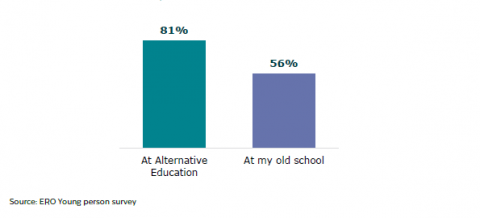
Source: ERO Young person survey
3. Behaviour
Whānau report their young person’s behaviour is improving at Alternative Education.
Whānau feel their young person’s behaviour has improved in Alternative Education, with 13 out of 22 saying their young person has better behaviour since being at Alternative Education. For those that do return to school, their school also noticed better behaviour (71 percent) when young people returned from Alternative Education.
Young people are learning to self-regulate their behaviour in Alternative Education.
Alternative Education improves young peoples’ self-regulation and behaviour while they are in the programme. From our survey of young people, two-thirds of young people are learning what to do when they experience stress (66 percent). During fieldwork, we observed young people implementing strategies for self-regulation, such as telling the educator they need a break and removing themselves from class.
“I am more calm.”
“I’m not as angry anymore.”
“I’m becoming more confident.”
- Young people attending Alternative Education
4. Progress in learning
Most young people in Alternative Education regularly discuss their goals with their educators.
Nearly nine in 10 (88 percent) young people in Alternative Education have goals that they talk about regularly with their educators.
Figure 20: Young people talking about their goals all of the time, or sometimes, at Alternative Education compared to at their old school
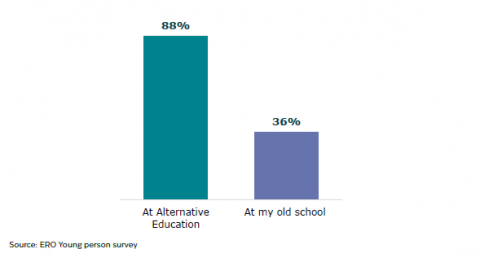
Source: ERO Young person survey
Two-thirds (65 percent) of young people know what they want to do when they leave Alternative Education. Of these young people, two-thirds (65 percent) feel that Alternative Education helps them reach their goals. Even when they do not know what they want to do, they still think Alternative Education is important for their future.
Four out of five (81 percent) of the young people think their work at Alternative Education is at the right level for them. Less than half (45 percent) thought it was the right level at their old school.
Figure 21: Young people who agree their work is the right level for them at Alternative Education compared to at their old school
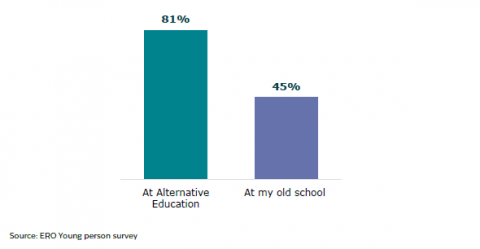
Source: ERO Young person survey
In interviews, many young people told us about their positive aspirations for the future and that they think Alternative Education will help them get there. They have a range of career aspirations, including becoming nurses, mechanics, builders, and ECE teachers. Very few young people (14 percent) would prefer to learn at their old school, and almost all want to enrol in another course or start work. Many older learners had plans to support this.
“I’ve planned to go back to [Alternative Education provider previously attending] and do the health and wellbeing course, and I’m wanting to go onto nursing.” - Young person attending Alternative Education
Conclusion
Young people have positive experiences at Alternative Education. They attend more and engage in their learning. They have a positive sense of belonging and wellbeing, and feel safer at Alternative Education compared to their previous school. They receive help when they need it, feel the work is at the right level for them, and discuss their progress towards their goals with their educators. It is usually a more positive experience than at their old school.
Part 5: What are their outcomes?
Young people have positive experiences in Alternative Education, but their outcomes are significantly worse than other young people; worse even than in a matched group of other young people with high needs. They are very unlikely to achieve an education qualification. They are more likely to be receiving benefits and be involved in the criminal justice system.
This section describes young people’s short- and long-term outcomes after Alternative Education, compared to young people in a matched group with similarly high needs and to the wider Aotearoa New Zealand population.
How we gathered this information
The findings in this section are based on:
- IDI data analysis, including a matched comparison group (see the box to the right for more detail on the matched comparison group)
- destination data from the Ministry of Education.
The matched comparison group
Using what we know about young people in Alternative Education, we looked in the IDI to find a group that has similar circumstances and needs as young people in Alternative Education, but have never attended Alternative Education.
This ‘matched comparison group’ looks like the group of young people who attend Alternative Education across 86 different variables, such as age, ethnicity, attendance history, and interactions with Oranga Tamariki and Youth Justice.
We compare the outcomes for young people who attended Alternative Education with outcomes for this matched comparison group. For more information about how we did this, see Social Wellbeing Agency (2023).
What we looked at
Many providers have been successful in engaging young people, resulting in increased attendance and more positive attitudes to learning, as well as helping young people to have aspirations and plans for the future.
To understand if Alternative Education delivers good outcomes for young people, we looked at their outcomes in the short term and longer term across:
- education
- employment
- social welfare receipt
- crime
- victim of crime
- health.
What we found: An overview
When they move out of Alternative Education, only around one in four return to school. Only one in four return to school immediately after leaving Alternative Education. One in seven go on to further education, training, or employment. More than half do not go on to school, further training, or employment.
Young people who attend Alternative Education are less likely to achieve a qualification. Less than one in 10 achieve NCEA Level 2 or higher. One in three young people in the matched comparison group achieve this, and four in five young people across the population achieve NCEA Level 2 or higher.
Young people who go to Alternative Education have a lower rate of employment as adults. At 18 years old, young people who have been to Alternative Education are less likely to be employed than 18-year-olds nationally. At age 24, about half of former Alternative Education participants are employed compared to three in five adults in the matched comparison group.
People who have been to Alternative Education are more likely to receive social welfare benefits. Young people who have attended Alternative Education are more likely to receive social welfare benefits than people in the matched comparison group. Nearly two thirds of young people who were in Alternative Education receive social welfare benefits at age 24, compared to half the matched comparison group and one in five of the population as a whole.
Past Alternative Education attendees are more likely to be alleged perpetrators of crime. At all ages, people who have attended Alternative Education are more likely to come to the attention of Police in relation to a crime. At age 24, one in seven adults who have been to Alternative Education served a custodial sentence, compared to less than one in ten adults in the matched comparison group.
Adults who went to Alternative Education are also more likely to be victims of crime. In the year they turned 24, one in 10 people who had attended Alternative Education reported to Police they were a victim of crime. Less than one in 20 of the total population are victims of crime at this age.
People who have been to Alternative Education are more likely to experience poor health than the general population. They have 1.2 times many hospital emergency department admissions as the the matched comparison group, and 2.5 times as many as the total population.
Outcomes comparison summary
We looked at 22 different outcomes across education, income, crime, and health. Adults who had attended Alternative Education had worse outcomes than adults in the matched comparison group.
Table 1 shows these differences. This section sets out these differences in more detail.
Table 1: Outcome comparisons between Alternative Education participants and similarly disadvantaged adults
Note: Significance shown at the 5 percent level. All outcomes are at age 20, except for at school at age 17. Red indicates a worse outcome.
1. Education outcomes
When young people move out of Alternative Education, only around one in four return to school. More than half do not go on to further training or employment.
Of those who started Alternative Education in 2019 and have a recorded outcome, 60 percent were not in education, employment, or training when they left Alternative Education. Twenty-six percent returned to school, 119ercent went to further education or training and 3 percent started employment.
Figure 22: Percentage of Alternative Education participants who first attended in 2019 and had a recorded outcome immediately after Alternative Education
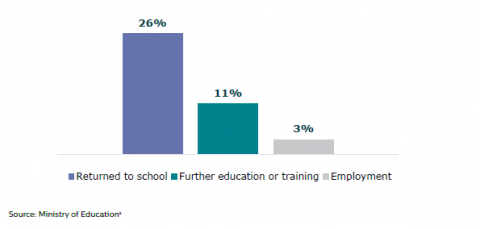
Source: Ministry of Education - Data shown is for young people who first attended Alternative Education in 2018, to minimise any Covid-19 effect. Values for other years are broadly similar.
Less than one in 10 young people in Alternative Education achieve NCEA Level 2 or higher.
NCEA level 2 is the minimum pre-requisite for higher education and training and many entry level jobs. Less than one in 10 young people (9 percent) in Alternative Education achieve this qualification, compared to nearly a third (32 percent) of young people in the matched comparison group, and nearly four out of five(78 percent) young people in the wider population.
Young people in Alternative Education consistently have lower qualification attainment than young people in the matched comparison group and all young people. Based on 2021 national figures.
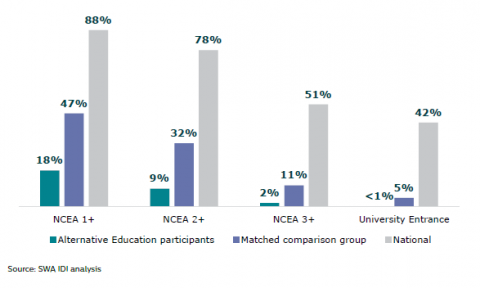
Source: SWA IDI analysis
Only three in 10 young people who attend Alternative Education are attending tertiary education at age 18, and by age 24 this drops to one in 10.
Young people who attend Alternative Education have low rates of enrolment in tertiary education, and appear to attend tertiary education for shorter periods of time than young people in the matched comparison group.
At age 18, there was no difference in education enrolment between young people who have been to Alternative Education and young people in the matched comparison group. The same proportion were attending school (6 percent of young people from Alternative Education, 6 percent of young people in the matched comparison group) and there was no difference in tertiary enrolment rates between young people who have been to Alternative Education and the matched comparison group (28 percent for both).
The tertiary enrolment rate at age 18 was also similar to that of the total population (25 percent).
However, at age 24, there were fewer young people in tertiary education in the Alternative Education group (11 percent) than adults in the matched comparison group (13 percent) and the total population (19 percent).
Figure 24: Participation in tertiary education: Alternative Education participants, matched comparison group, and national figures
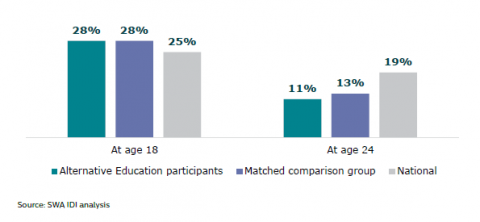
Source: SWA IDI analysis
2. Employment outcomes
At age 24, just over five in 10 adults who went to Alternative Education are employed, compared to six in 10 adults in the matched comparison group and seven in 10 nationally.
Fewer young people who had been in Alternative Education earn money through employment than young people in the matched comparison group.
- At age 18, 49 percent of young people who had been to Alternative Education are in employment, compared to 58 percent of young people in the matched comparison group and 63 percent nationally. They were employed at any point during the year.
- At age 24, 53 percent of young people who had been to Alternative Education were employed, compared to 60 percent of young people in the matched comparison group and 70 percent nationally.
Figure 25: Employment rates: Alternative Education participants, matched comparison group, and national figures
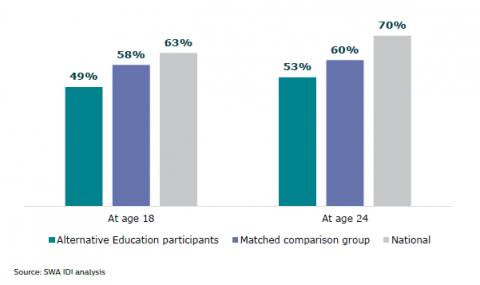
Source: SWA IDI analysis
Each year the wage gap between adults who attended Alternative Education and other adults grows.
Income for both people who have been to Alternative Education and the matched comparison group is low, but adults who went to Alternative Education progressively earn less.
- At age 18, young people who had been to Alternative Education received $9,000 per year, compared to $10,000 for young people in the matched comparison group and $11,500 for the total population. All income and wage values have been rounded to the nearest $500
- At age 24, adults who had been to Alternative Education received $19,000 per year, compared to $22,500 for adults in the matched comparison group and $35,500 for the total population
- At age 30, adults who had been to Alternative Education received $23,500 per year, compared to $28,500 for adults in the matched comparison group and $51,000 for the total population.
The gap in wages (money received for doing work) is even greater.
- At age 18, people who had been to Alternative Education earned $5,500, compared to $7,000 for young people in the matched comparison group and $10,000 for the total population.
- At age 24 people who had been to Alternative Education earned $11,000 from wages, compared to $16,000 for the adults in the matched comparison group and $31,500 for the total population.
- By age 30, people who had been to Alternative Education earned $13,500, compared to $19,500 for the adults in the matched comparison group and $44,500 for the total population.
Figure 26: Income from wages: Alternative Education participants, matched comparison group, and national figures
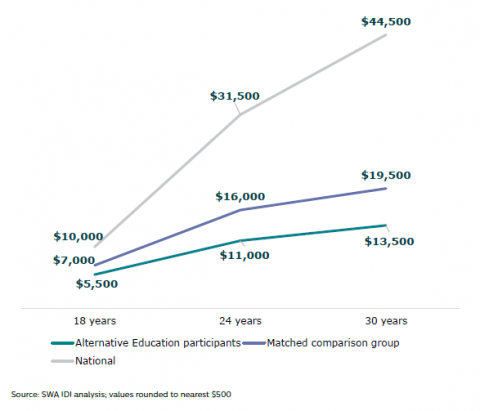
Source: SWA IDI analysis; values rounded to nearest $500
3. Social welfare benefit receipt
At age 24, almost two-thirds of people who had attended Alternative Education were receiving a benefit, compared to half of adults in the matched comparison group.
The number of people receiving a benefit increased with age and the difference between groups increased over time.
- Half (52 percent) of the Alternative Education group received a social welfare benefit at age 18, compared to 40 percent of young people in the matched comparison group and 12 percent of the total population.
- The proportion receiving a benefit peaks at age 20, where 68 percent of the Alternative Education group received a benefit, compared to 56 percent of the matched comparison group and 22 percent of the total population.
- At age 24, 63 percent of people who had been to Alternative Education received a benefit, compared to 51 percent of adults in the matched comparison group and 19 percent of the total population.
Figure 27: Receiving social welfare support, age 17 to 30: Alternative Education participants, matched comparison group, and national figures
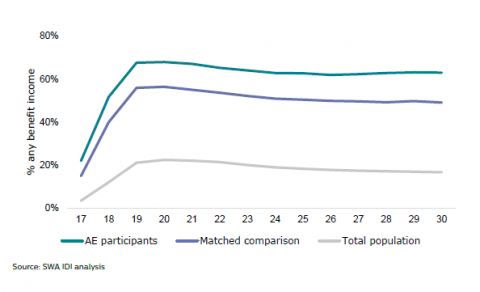
Source: SWA IDI analysis
4. Crime
At age 24, 14 percent of young people who attended Alternative Education were serving a custodial sentence.
In the year they turned 18, 9 percent of people who had been to Alternative Education were serving a custodial sentence, compared to 4 percent of young people in the matched comparison group and less than 1 percent of the total population.
In the year they turned 24, 14 percent of people who had been to Alternative Education were serving a custodial sentence, compared to 8 percent of adults in the matched comparison group and 1 percent of the total population.
Figure 28: Custodial sentence: Alternative Education participants, matched comparison group, and national figures
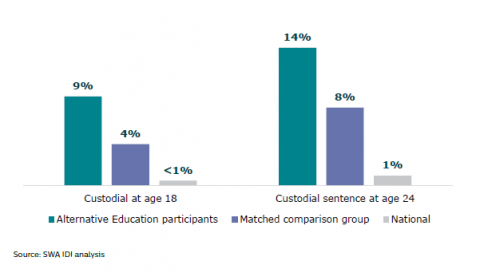
Source: SWA IDI analysis
Reported offending was high for both groups but decreased over time.
- In the year they turned 18, 39 percent of young people who attended Alternative Education had Police proceedings against them in relation to an offence, compared to 25 percent of young people in the matched comparison group and 6 percent of the total population.
- In the year they turned 24, 28 percent of people who had been to Alternative Education had Police proceedings against them in relation to an offence, compared to 20 percent of adults in the matched comparison group and 4 percent of the total population.
Many of these alleged offences were violent.
- In the year they turned 18, 16 percent of adults from Alternative Education had Police proceedings against them for a violent offence, compared to 10 percent of young people in the matched comparison group and 2 percent of the total population.
- In the year they turned 24, 12 percent of adults from Alternative Education had Police proceedings against them for a violent offence, compared to 9 percent of adults in the matched comparison group and 2 percent of the total population.
5. Victim of crime
In the year they turned 24, young people who attended Alternative Education were more likely to be a victim of crime, compared to young people in the matched comparison group.
Not only are adults who went to Alternative Education more likely to commit crime, they are also more likely to be victims of a crime.
- In the year they turned 18, six percent of adults who went to Alternative Education were victims of crime, compared to 5 percent of young people in the matched comparison group and 2 percent of the total population.
- In the year they turned 24, 11 percent of people who had been to Alternative Education were victims of crime, compared to 8 percent of adults in the matched comparison group and 4 percent of the total population.
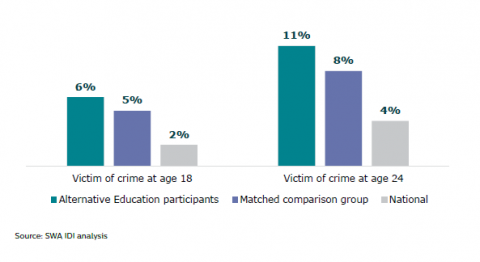
Source: SWA IDI analysis
This group is also more likely to be victims of violent crime.
- In the year they turned 18, 5 percent of adults who went to Alternative Education were a victim of violent crime, compared to 4 percent of young people in the matched comparison group and 1 percent of the total population
- In the year they turned 24, 8 percent of adults who went to Alternative Education were a victim of violent crime, compared to 6 percent of adults in the matched comparison group and 2 percent of the total population.
Figure 30: Victim of a violent crime: Alternative Education participants, matched comparison group, and national figures
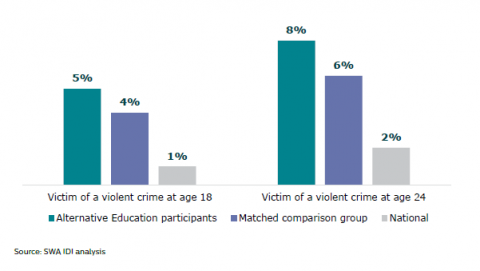
Source: SWA IDI analysis
6. Health
Adults who had been to Alternative Education are admitted to hospital emergency departments significantly more often than others.
Adults who went to Alternative Education have about the same number of avoidable hospitalisations, and see their doctor about as often as the matched comparison group.
Adults who went to Alternative Education have more hospital emergency department admissions than the matched comparison group, and more than the broader population.
- In the year they turned 18, adults who went to Alternative Education had, on average, 0.58 admissions to emergency departments, compared to 0.48 admissions for adults in the matched comparison group and 0.23 admissions for the total population.
- In the year the turned 24, adults who went to Alternative Education had, on average, 0.56 admissions to emergency departments, compared to 0.49 admissions for adults in the matched comparison group and 0.23 admissions for the total population.
Figure 31: Average number of Emergency Department admissions, by age
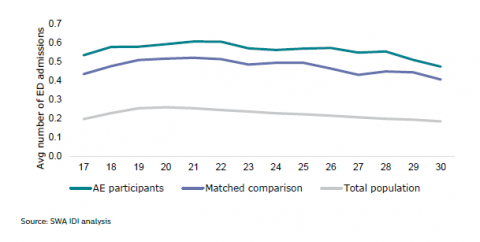
Source: SWA IDI analysis
Conclusion
Most young people who have been to Alternative Education leave the education system without the skills and qualifications needed to achieve positive outcomes in life. They experience much poorer employment outcomes and reduced income in adulthood, compared to young people in the matched comparison group and the wider population. They also have higher rates of criminal offending, and more likely to be a victim of crime. They are more likely to be admitted to hospital through an Emergency Department.
The cost of not meeting the needs of young people in Alternative Education is high, both for the young people themselves, their families and communities, and wider society. Increased benefit payments and increased custodial sentences are flow on costs as a result of not supporting young people in Alternative Education to achieve. The increased rates of criminal offending also impacts those who are victims of their crimes, both in terms of their mental health and sense of safety, and the financial costs. For many young people, Alternative Education is the last chance to turn this around. Unfortunately, it is a lost opportunity.
Part 6: What are the experiences and outcomes of Alternative Education for different groups of young people?
There are few differences in the experiences and outcomes of young people in Alternative Education. Across different groups they all attend more, enjoy learning more, feel safer and have a stronger sense of belonging in Alternative Education. They also have consistently poorer outcomes.
This chapter explores the outcomes and experiences for Māori young people, Pacific young people, female young people, young people who are in Oranga Tamariki care, disabled young people, and 13‑year-olds.
How we gathered information
We used interview and survey data for each group and compared their responses to the rest of the respondents. We also used what we know from the IDI to compare the outcomes for different groups, compared to the matched comparison group of young people.
Most young people in Alternative Education are Māori and male, and so their experiences are the main experiences we describe in this report. There are smaller numbers of Pacific young people, female young people, young people in Oranga Tamariki care, disabled young people and 13‑year‑olds. We have highlighted where there may be difference in survey responses.
Based on the combination of IDI data, survey responses, interviews, and observations we describe what is the same, and what may be different for:
- Māori young people in Alternative Education
- Pacific young people in Alternative Education
- young people of different genders in Alternative Education
- young people in Oranga Tamariki care in Alternative Education
- disabled/neurodivergent young people in Alternative Education
- very young people in Alternative Education.
For each group, we discuss:
- why they are in Alternative Education
- their experiences at Alternative Education
- their outcomes after Alternative Education.
What we found: An overview
Māori young people may be more likely to be attending Alternative Education due to behaviour-related standdowns and suspensions or exclusions. When in Alternative Education Māori young people are more engaged in their learning and see the value in it for their futures, generally feel cared for, and rarely feel lonely. Māori young people who go to Alternative Education are learning positive behaviours. Like all young people in Alternative Education, Māori young people who attend Alternative Education have worse outcomes than young people who do not attend Alternative Education. There is a larger gap for education and income outcomes for non-Māori young people in Alternative Education compared to Māori young people in Alternative Education.
Pacific young people tend to be enrolled at Alternative Education because they, or their whānau, want them to be. While there, they have positive relationships. They enjoy learning, and are more likely to see it as important for their future than non-Pacific young people. Most feel positive about their progress in behaviour and learning. Pacific young people who attend Alternative Education have worse outcomes than young people who do not attend Alternative Education. There is a larger gap in education outcomes between Pacific and nonPacific young people in Alternative Education.
Female young people at Alternative Education have a slightly different experience to male young people. Females may be more likely to go to Alternative Education because of anxiety, alienation, and chronic absences. Both male and female young people are more positive in feelings of wellbeing and belonging once they are in Alternative Education. Young women and young men in Alternative Education have worse outcomes than young people not in Alternative Education. There is a larger gap in future education outcomes for females compared to males, and a larger gap for criminal offending for males compared to females.
Young people in Oranga Tamariki care often have Alternative Education as one of their only options, and are often enrolled on request of their school. Once there, they have positive relationships and are rarely lonely. They are more likely to enjoy their learning, and feel like it helps them to achieve their goals.
Disabled young people (including neurodivergent young people) are often at Alternative Education because their school requested it. They also have someone who cares for them in Alternative Education. However, they feel lonely more often, are less likely to see education as important for their future, and are less positive about their progress in learning.
Younger learners (13-year-olds) are enrolled at Alternative Education on request of their school. Younger learners tend to have good learning experiences and strong connections with others around them while in Alternative Education. We heard that the number of younger learners is increasing, and that a different approach is needed to meet their needs. There is a larger gap for income and criminal outcomes for young people who start Alternative Education aged 13.
1. Māori young people in Alternative Education
Māori young people are largely over-represented in Alternative Education, making up 68 percent of the young people enrolled. Outside of Alternative Education, Māori young people make up just 24 percent.
Why Māori young people are in Alternative Education
Māori young people may be more likely to be referred to Alternative Education because of their behaviour.
Māori young people may be more likely than non-Māori to have a request for support from Alternative Education due to behaviour-related stand downs, suspensions, and exclusions. Fifty-one percent of Māori young people are in Alternative Education 'because school wanted me to', compared to 42 percent of non-Māori young people.
Māori young people’s experiences in Alternative Education
While in Alternative Education, Māori young people are engaged in learning, have a sense of belonging, and have improved behaviour.
Māori young people may be more engaged than non-Māori in their education while at Alternative Education. Seventy-three percent enjoy learning at Alternative Education compared to 54 percent of non-Māori. Sixty-four percent feel education is important for their future, compared to 51 percent for non‑Māori young people.
Māori young people may feel a stronger sense of belonging at Alternative Education.
Most Māori young people rarely feel lonely at Alternative Education and most have someone who cares about them. Eighty-four percent of Māori young people report they never, or rarely ever feel lonely, compared to 75 percent for non-Māori. Eighty-seven percent feel there is someone who cares about them, compared to 75 percent of non‑Māori.
Most Māori young people are improving their behaviour at Alternative Education.
Sixty-five percent are learning what to do when stressed, similar to 69 percent of non-Māori young people.
Māori young people in Alternative Education are positive about their learning.
Eighty percent of Māori young people believe their work at Alternative Education is the right level for them compared to 83 percent for non-Māori.
Of those who know what they want to do after Alternative Education, 66 percent said Alternative Education helps them work toward their goals, compared to 64 percent for non‑Māori. Eighty-seven percent talk about their goals with their educators at least sometimes, compared to 89 percent for non-Māori.
“I’m learning things and actually sorting out my life career.” - Māori young person in Alternative Education
Māori young people’s outcomes after Alternative Education
Like all groups at Alternative Education, Māori young people experience worse outcomes than young people in the matched comparison group.
Māori young people in Alternative Education are less likely to achieve NCEA qualifications than Māori young people in the matched comparison group. However, the gap in education outcomes between those who attended Alternative Education and the matched comparison group may be less for Māori than for non-Māori.
Figure 32: NCEA achievement: Māori and non-Māori
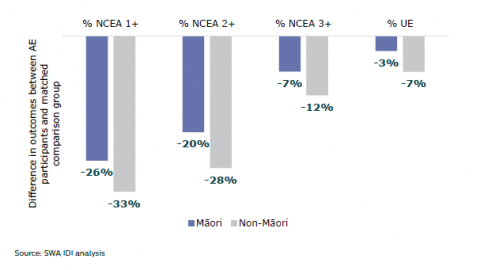
Source: SWA IDI analysis
Similarly, Māori young people in Alternative Education have lower incomes than Māori young people in the matched comparison group. However, the gap in incomes between those who attended Alternative Education and the matched comparison group may be less for Māori than for non-Māori.
Figure 33: Income from wages: Māori and non-Māori
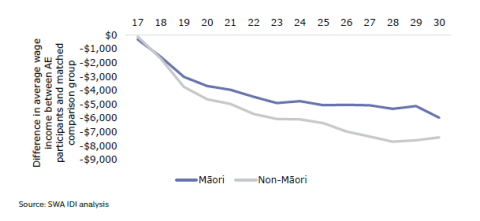
Source: SWA IDI analysis
2. Pacific young people in Alternative Education
Historically, 17 percent of young people in Alternative Education are Pacific. Outside of Alternative Education, Pacific young people make up 12 percent of learners.
Why Pacific young people are in Alternative Education
More Pacific young people enrol at Alternative Education because they or their whānau wanted them to, compared to non-Pacific young people.
They may be less likely to go to Alternative Education because their school wanted them to (9 of 24, or 38 percent compared to 51 percent for non-Pacific).
Pacific young people’s experiences in Alternative Education
The majority of Pacific young people are engaged in their education, and more see education as important for their futures.
Eighteen of 23 (78 percent) see school as important for their future, while just over half (57 percent) of non‑Pacific young people say the same.
Sixteen of 24 (67 percent) enjoy learning at Alternative Education, which is the same for non-Pacific young people.
Pacific young people in Alternative Education have positive wellbeing experiences.
Twenty of 24 never, or almost never, feel lonely at Alternative Education (83 percent compared to 81 percent for non-Pacific). Most Pacific young people feel someone cares about them at Alternative Education (21 or 24, compared 88 percent compared to 82 percent for non-Pacific).
More than two-thirds of Pacific young people are learning what to do when they get stressed.
Seventeen out of 24 (71 percent) Pacific young people are learning what to do when they get stressed, compared to 65 percent of non-Pacific young people.
Most Pacific young people have positive learning experiences at Alternative Education, but they are less likely to believe it helps with their goals.
Of those who know what they want to do after Alternative Education, 10 of 18 believe it helps them get there (56 percent, compared to 68 percent for non-Pacific).
Nineteen of 23 Pacific young people believe the work at Alternative Education is the right level for them (83 percent, compared to 81 percent for non-Pacific).
Pacific young people talk about their goals with their educators less frequently than non-Pacific young people. Nineteen of 24 talk about their goals with their educators at least sometimes (79 percent, compared to 90 percent for non-Pacific).
“I’ve learnt to calm myself down when I got stressed.” - Pacific young person in Alternative Education
Pacific young people’s outcomes after Alternative Education
Like all groups at Alternative Education, Pacific young people experience worse outcomes than young people in the matched comparison group.
Pacific young people in Alternative Education are less likely to achieve NCEA qualifications than Pacific young people in the matched comparison group. The gap in educational outcomes between those who attended Alternative Education and the matched comparison group is larger for Pacific than non-Pacific.
Figure 34: NCEA Achievement: Pacific and non-Pacific
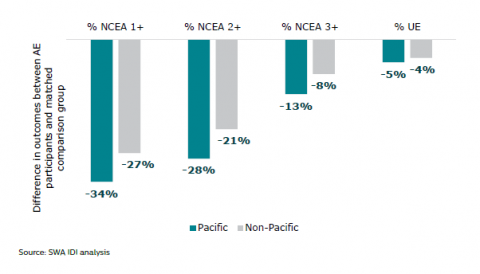
Source: SWA IDI analysis
3. Different genders at Alternative Education
In our survey, we asked young people to select the gender they identify as. Only one person selected ‘prefer not to say’, and nobody selected ‘another gender’. This section therefore only discusses responses from young people who selected ‘female’ or ‘male’ as their gender.
Why male and female young people are in Alternative Education
Males may be more likely to enrol in Alternative Education for behaviour related reasons, but the picture for females is changing.
In interviews with providers and contract-holding schools, we heard that the reasons for requests for Alternative Education for females are different and more likely to include anxiety, alienation, and chronic absences. In our surveys, males may be more likely to have a request for support from Alternative Education made by the school compared to females (51 percent compared to 43 percent of females). Females are more likely to seek support from Alternative Education themselves, or through their family.
Male and female young people’s experiences in Alternative Education
Females may find their learning at Alternative Education more engaging.
Three quarters (77 percent) of females enjoy learning at Alternative Education, compared to nearly two thirds (63 percent) of males. Similarly, 71 percent of females are likely to think education is important or very important, compared to 56 percent of males.
Across genders, young people from Alternative Education are comfortable in their relationships.
They rarely feel lonely (2 percent of females report feeling lonely every day or almost every day in Alternative Education, compared to 1 percent of males) and both females (84 percent) and males (84 percent) feel someone cares about them at Alternative Education.
Males may feel they are developing their self-regulation skills more than females.
Males (71 percent) may be more likely to be learning what to do when they are stressed than females (59 percent).
Males may be more positive about their learning at Alternative Education.
Of those who know what they want to do after Alternative Education, more males (69 percent) than females (63 percent) think Alternative Education helps them to reach their goals. Similarly, more males (85 percent) feel the work at Alternative Education is the right level for them than females (76 percent). Almost all males (90 percent) talk about their goals with their educators at least sometimes, compared to 84 percent of females.
[I am proud of] “me getting over my social anxiety.” - Female young person in Alternative Education
[I am proud of] “learning to carve.” - Male young person in Alternative Education
Male and female young people’s outcomes after Alternative Education
All groups of young people in Alternative Education achieve poorer outcomes than the matched comparison group.
In particular, we are concerned that there is a larger gap between Alternative Education participants and the matched comparison group in future education outcomes for females compared to males, and criminal offending for males compared to females.
Figure 35: NCEA achievement: Females and males
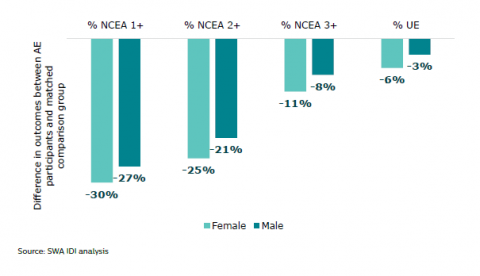
Source: SWA IDI analysis
Figure 36: Custodial sentence: Females and males
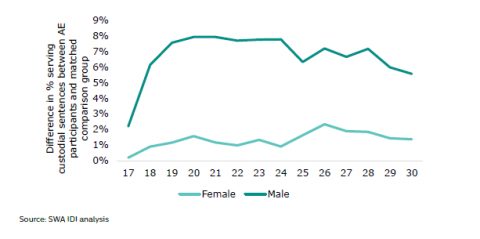
Source: SWA IDI analysis
4. Young people in Oranga Tamariki care at Alternative Education
One in six (17 percent) young people in Alternative Education have been in Oranga Tamariki care.
Why young people in Oranga Tamariki care are in Alternative Education
Similar to others, almost half of young people in Oranga Tamariki care had a request for support for Alternative Education made by their school.
Seven of 15 (47 percent) of young people who attend Alternative Education, and are in Oranga Tamariki, were in Alternative Education due to a request for support from their school. This compares to 52 percent of young people in Alternative Education, and not in care.
Oranga Tamariki officials told us some schools will not accept children or young people in their care. This means Alternative Education is the only option available, even if it is not the best option for the individual young person.
Young people in Oranga Tamariki care experiences in Alternative Education
Young people in Oranga Tamariki care are more engaged in their learning.
Compared to those not in Oranga Tamariki care, those in care may be more likely to enjoy learning at Alternative Education (12 of 15, or 80 percent compared to 66 percent). This group of young people may also be more likely to see value in their learning, with 10 of 14 (71 percent) telling us that they see education as being important for their future (compared to 59 percent of young people not in Oranga Tamariki care).
Those in Oranga Tamariki care feel similarly comfortable and cared for at Alternative Education, as those not in Oranga Tamariki care.
Most young people in Oranga Tamariki care have someone who cares about them at Alternative Education (13 of 15, or 87 percent, compared to 84 percent not in care). Twelve of 15 never, or almost never feel lonely there (compared to 84 percent not in care).
Young people in Oranga Tamariki care may be more likely to be learning to improve their behaviour.
Twelve of 15 young people in Oranga Tamariki care feel they are learning what to do when they get stressed, compared to 64 percent of those not in care.
Those in care may be more positive about their learning at Alternative Education.
Young people in Oranga Tamariki care feel their work is the right level for them (14 of 15, 93 percent compared to 82 percent of young people not in care). Of those who know what they want to do after Alternative Education, over half feel as though it helps them get to their goals (six of 11, or 55 percent, compared to 65 percent not in care).
All young people in Oranga Tamariki care who responded to our survey talk to their educators about their goals for learning at least sometimes, compared to 88 percent of those not in care.
[I am proud of] “my confidence and cooperation.” - Young person in Oranga Tamariki care in Alternative Education
5. Disabled/neurodivergent young people in Alternative Education
Historically, 10 percent of young people in Alternative Education have ADHD, compared to three percent outside of Alternative Education. Two percent of young people in Alternative Education have some form of intellectual disability, compared to one percent outside of Alternative Education.
Why disabled young people are in Alternative Education
Disabled young people (including neurodivergent young people) may be more likely to have a request for support from Alternative Education made by their school.
Twelve out of 18 disabled young people, or 67 percent are in Alternative Education due to a request for support from their school, compared to 45 percent for non‑disabled young people.
Disabled young people’s experiences in Alternative Education
Disabled young people may not be as engaged in their education in Alternative Education.
Nine of 17 disabled young people feel education is important for their future (53 percent) which is lower than non-disabled young people (67 percent). Eleven of 17 (65 percent) enjoy their learning compared to 71 percent of non-disabled young people.
Disabled young people may be lonely at Alternative Education.
Six of 18 (33 percent) feel lonely at least once or twice a month, compared to just 15 percent of non-disabled young people at Alternative Education.
However, disabled young people in Alternative Education do have someone who cares about them. Fifteen of 18 disabled young people feel there is someone who cares about them in Alternative Education (83 percent, compared to 88 percent of non-disabled young people).
Most disabled young people are improving their behaviour in Alternative Education.
Fifteen of 18 (83 percent) are learning what to do when stressed, compared to 69 percent of non‑disabled young people.
Disabled young people may be less positive about their learning than non-disabled young people.
Fourteen of 18 (78 percent) feel the work is at their level in Alternative Education (compared to 87 percent of non-disabled young people). Fifteen of 18 (83 percent) talk to their educators about their learning at least sometimes, compared to 93 percent of non-disabled young people.
Of those who know what they want to do after Alternative Education, 6 of 11 (55 percent) believe Alternative Education will help them get to their goals (compared to 66 percent of non-disabled young people).
[I am proud of] “being able to talk about my problems, not being shy to ask for help.” - Disabled young person in Alternative Education
6. Very young people in Alternative Education
Eight percent of young people first attend Alternative Education aged 13.
Why very young people are in Alternative Education
Younger learners may be more likely to have a request for support from Alternative Education from their school.
Eleven of 17 (65 percent) of 13-year-olds are at Alternative Education because of a request for support made by their school, compared to 44 percent of older learners. We heard from Alternative Education providers that the number of younger learners is growing, some coming directly from primary or intermediate schools.
Very young people’s experiences in Alternative Education
Thirteen-year-olds may be more engaged in their learning than older learners.
Younger people may be more likely to enjoy their learning at Alternative Education (15 of 16, or 94 percent compared to 63 percent of older learners). They may also be more likely to think school is important for their futures (12 of 17, or 71 percent, compared to 59 percent of others).
Providers told us that a different approach from Alternative Education is needed for younger learners, and it is important to keep them in school as long as possible.
This group of young people have similarly strong relationships at Alternative Education.
Fifteen of 17 (83 percent) have someone who cares about them (compared to 83 percent of older learners), and 13 of 17 (76 percent) never, or almost never feeling lonely (compared to 82 percent of older learners).
Thirteen-year-olds are improving their behaviour.
Twelve of 16 younger people (75 percent) may be more likely to be learning what to do when they get stressed, more than older learners in Alternative Education (65 percent).
Thirteen-year-olds are positive about their learning at Alternative Education.
Fifteen of 17 (88 percent) feel the work is the right level for them (compared to 80 percent of older learners). Of those who know what they want to do after Alternative Education, 8 of 12 (67 percent) feel it helps them work toward their goals (compared to 65 percent of older learners). However, older learners may talk to their educators more often (90 percent, compared to 13 of 17, or 76 percent of 13-year-olds).
[I am proud of] “helping people, listening to the tutors/teachers, doing as I’m told.” - 13-year-old in Alternative Education
Very young people’s outcomes after Alternative Education
As with other groups, young people who start Alternative Education aged 13 have worse outcomes than the matched comparison group.
There is a larger gap in future income and criminal offending for young people enrolling at age 13 compared to young people who enrolled at age 15 or 16. Young people who start attending Alternative Education aged 13 earn less, and are more likely to serve a custodial sentence, than the matched comparison group or learners who start attending Alternative Education aged 16.
Figure 37: Income from wages: Started Alternative Education at age 13 and age 16
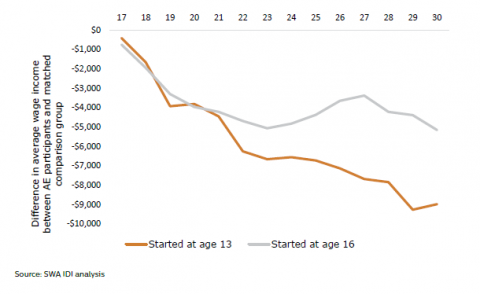
Source: SWA IDI analysis
Figure 38: Custodial sentence: Started Alternative Education at age 13 and age 16
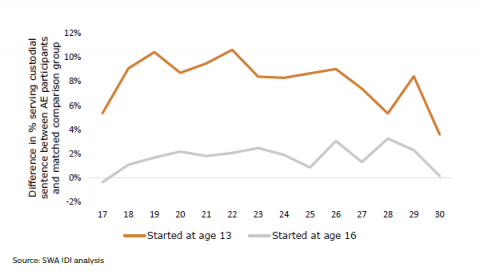
Source: SWA IDI analysis
Conclusion
All groups have positive experiences at Alternative Education, but there are some differences in the extent of these. Māori young people may be more engaged in their learning. Pacific young people and young people in Oranga Tamariki care may be more likely to see education as important for their future. Female young people may be more likely to go to Alternative Education because of anxiety, alienation, or chronic absences. Disabled young people may feel lonely more often, and less positive about their progress in learning. Young people who start at Alternative Education aged 13 may be more likely to be there due to their behaviour. All groups of young people in Alternative Education achieve worse outcomes than the matched comparison group.
Part 7: Why are the outcomes so poor for young people in Alternative Education?
Alternative Education does not provide good outcomes. The current model of Alternative Education is inadequate to meet the need of these often highly disengaged young people, leading to worse outcomes than for other young people.
Critical elements of the model, such as the poor quality of teaching and resources, poor quality facilities, inadequate funding and isolation, limit providers’ ability to help young people succeed.
How we gathered information
To understand why the outcomes are so poor for young people in Alternative Education, we gathered the views of young people and their parents/whānau through interviews and surveys. We also conducted surveys and interviews with leaders at schools young people in Alternative Education are enrolled at, leaders at contract-holding schools, Alternative Education providers, and educators.
To get a deeper understanding of the practice happening in Alternative Education, we analysed documents and observed teaching and interactions at 22 providers, across 11 contract-holding schools.
We found concerns with the:
- quality of teaching
- teaching resources
- quality of facilities
- sufficiency of funding
- stability of educators and providers
- connections and support for staff
- accountability for delivery and outcomes
- options available to young people who are the most disengaged from learning.
What we found: An overview
Teaching is weak, and teaching resources are inadequate. Less than one in five educators are registered teachers. Only one in five are confident in helping young people with their literacy, and just over a third are confident in helping with their numeracy. These educators lack professional learning development, and over one in five want more support in literacy and one inf five for numeracy teaching.
Facilities are often so run down they act as a barrier to learning. Of the 22 sites we visited, six were of poor quality. We heard that spaces can be unsafe, and the poor quality of the premises acted as a barrier to young people’s learning.
Funding is inadequate. Young people in Alternative Education have some of the highest needs in the education sector. The funding for Alternative Education does not reflect this need, and is lower than that for some small secondary schools.
Funding limitations make it unviable for many providers, and provider and staff turnover is high. Two in five educators have worked in Alternative Education for two years or less. Leaders of contract-holding schools reported challenges with providers closing due to not being able to afford to stay open.
Providers are often isolated from other providers and schools, so they often lack access to broader education resources. Providers reported little interaction with contract-holding schools outside referral and reporting processes. Few accessed schools’ wider resources, such as specialist teachers or sports and cultural activities.
Providers cannot always access the broader wrap-around support young people need. Just over half of providers have access to learning needs support, and less than two thirds have access to behaviour support. There are challenges in accessing community‑based support, such as counsellors.
Accountability for delivery and outcomes is weak. While the schools young people are enrolled at maintain responsibility for their young people’s outcomes when they attend Alternative Education, in practice, they do little to ensure they achieve. System-level data, monitoring, and accountability is also weak.
There are few options for young people who are most disengaged from learning other than Alternative Education. The lack of other options means many young people become further disengaged from learning.
1. Quality of teaching
The workforce is largely unqualified to teach.
Evidence shows qualified teachers are key to quality teaching.46 Very few educators in Alternative Education are registered teachers (19 percent); a quarter have a qualification eligible for teacher registration. Some are trained in other professions, such as social work, but have limited knowledge of the curriculum or ways of teaching.
“…these kids… are the most vulnerable and they actually deserve our best teachers.” - Alternative Education consortium leader
“And then they're paying people who are passionate about youth, not necessarily [those who] have got the skills to work with young people, but really passionate about wanting to be in that environment.” - Contract-holding school leader
Figure 39: Educator qualifications
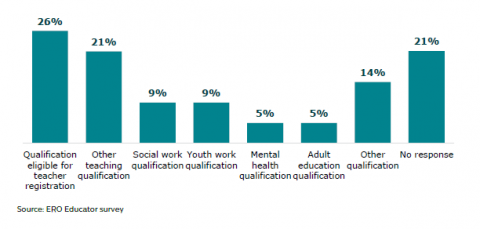
Source: ERO Educator survey
Qualified teachers in Alternative Education are not always focused on teaching; many are contributing to the pastoral care of young people.
“The staffing model needs to change, in schools with more priority learners – needs based, the pastoral system needs to be stronger, with roles allocated to behaviour and attendance and counsellors in every school. Right now the curriculum staffing is supporting pastoral staffing” - Consortium leader
It is difficult for teachers in Alternative Education to maintain their teaching certification, as the hours of work are not sufficient and they do not meet the criteria for certification.
Only one in five educators are confident in helping young people with their reading and one inf five with their writing, and just over a third are confident helping them with their numeracy.
Nineteen percent of educators are confident in helping young people with their reading and 19 percent with their writing, and 37 percent are confident in helping young people with their numeracy. Educators are more confident supporting stable routines, providing feedback, and managing behaviour.
During site observations, we saw educators using photocopies of old worksheets, with outdated and disproven ideas.
Figure 40: Educators who identified numeracy, reading, and writing as a strength
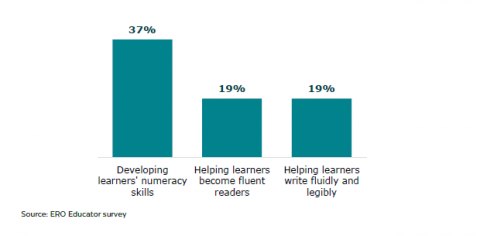
Source: ERO Educator survey
Only a third of educators in Alternative Education are confident using progress and assessment information.
While 67 percent of educators said that they recognise the strengths of the young people they teach and give them the feedback to work towards their next steps, only 35 percent of the educators are confident looking at progress and assessment information over time to help young people progress towards their goals. Only two in five (40 percent) are confident with identifying what the young people know about a topic or subject before the lesson.
Figure 41: Educators who identified assessment as a strength
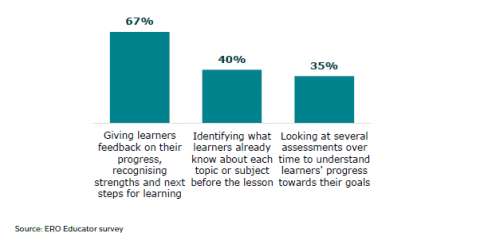
Source: ERO Educator survey
During our site visits we observed variable practices in the use of assessment data to develop individualised and responsive teaching. We also noticed that the information about the young person’s prior knowledge was rarely used to develop their learning material. Where we saw limited use of assessment, we also saw use of photocopied worksheets.
In interviews, young people told us some of the work they did was not well-suited to their interests or career aspirations.
Adaptation of teaching for individual young people is critical to re-engaging these young people in learning. Sixty-seven percent of the educators said that they are confident using different approaches for different young people, but less than half (42 percent) are confident to use the information provided in the individual education or learning plans to adapt their teaching.
“Paper-based, outdated pedagogy is used with a lot of teacher-led instructions… some may not be confident in delivering online content in a differentiated way… curriculum adaptation could be better supported” - Alternative Education leader
Figure 42: Educators who identified adapting teaching as a strength
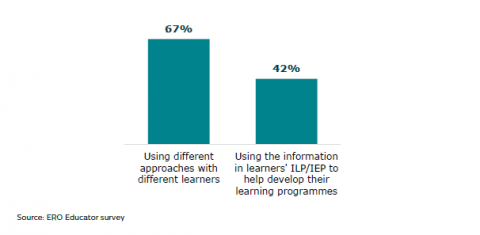
Source: ERO Educator survey
Educators do not have sufficient access to professional learning and development.
In our survey, one in five educators said they want more support with teaching literacy (21 percent) and numeracy (23 percent). Six out of 21 providers want more support for their staff to help young people become fluent readers and seven out of 20 want more support for their staff to help young people write fluidly and legibly. Six out of 21 providers want more support for their staff to develop young people’s numeracy skills. One in five educators (20 percent) report they are not supported to improve their skills.
Half of providers we surveyed (11 out of 22) say their educators do not have access to appropriate professional learning and development opportunities, and nearly one in three educators (29 percent) do not have opportunities to learn from others.
In interviews, we heard it is difficult for educators to access professional learning and development and, when they can, it often does not reflect or recognise the Alternative Education context.
2. Teaching resources
Half of Alternative Education providers and educators lack the education resources to support learning.
Alternative Education providers lack access to up-to-date teaching resources. Only half of educators have the resources they need to do their job. One quarter of providers (5 of 21) lack access to curriculum resources, and three out of 21 providers do not have access to digital technology.
“There is technology poverty, we fundraised for 15 chrome books.” - Alternative Education provider
Figure 43: Provider and educator access to resources
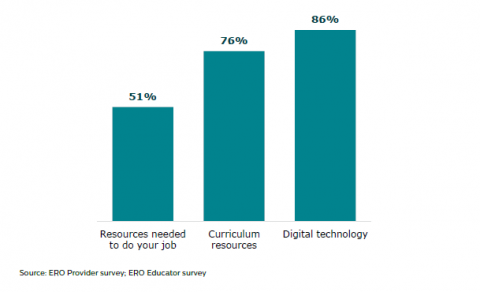
Source: ERO Provider survey; ERO Educator survey
In interviews, we heard educators find it challenging to find resources that are both at the appropriate curriculum level and are interesting and engaging for young people in Alternative Education. Young people told us some of the work they did was not a good fit for their interests and often aimed at younger learners.
Young people in Alternative Education risk missing out on many opportunities available in secondary schools.
While the model expects that contract-holding schools and the schools young people are enrolled at support Alternative Education providers and young people in Alternative Education, in practice, support is highly variable.
Providers and educators told us it was a challenge to access the breadth of learning opportunities available in secondary schools – for example, specialist teachers in sciences, languages, and technology, and the specialist facilities to support that learning, like opportunities to use laboratories and workshops.
Due to their small size, and limited staff, Alternative Education providers are also limited in their ability to offer a variety of sporting and cultural activities.
3. Quality of facilities
Many young people attend Alternative Education facilities that are so run down they are a barrier to learning.
Having inadequate facilities hinders progress in learning and achievement. It can lead to providers, young people, and educators feeling unsafe in the space, and unable to teach and learn to the best of their abilities.
We visited 22 Alternative Education sites and found six operating out of poor quality or inadequate facilities.
This included sites that:
- Are of poor quality, damp, run down with poor electricity and poor internet connection
- are too small to adequately accommodate the number of young people and staff
- present accessibility challenges with uneven floors, many stairs, cramped pathways, and bathrooms that are difficult to access
- lack any outdoor areas or breakout spaces.
“So they were in the most run down building… and it was not a space that had any mana, or had any respect for the students in it. It was not adequate for their needs.” - Contract-holding school leader
4. Sufficiency of funding
Funding levels are inadequate to meet the needs of this vulnerable group of young people.
Despite being a group with very high needs and who experience poor outcomes, young people in Alternative Education are one of the least funded groups in the education sector. At the time we did the evaluation, Alternative Education providers received significantly less funding per learner than some schools with a small number of learners.
For example, looking at the funding received by schools with under 100 learners in 2021, one school with 98 learners received $16,553 per learner and another with 29 learners received $36,760 per learner.
Figure 44: Funding per place
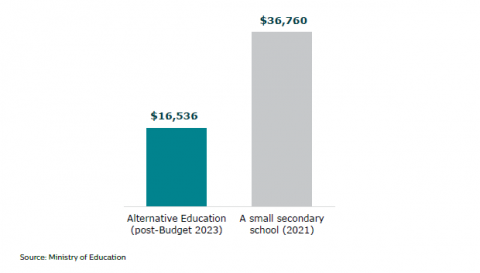
Source: Ministry of Education
This is an example of one small school (with 29 learners) in 2021.
The increase in Budget 2023 raises funding levels from $12,720 per placement to $16,536.
Budget 2023 recently allocated an additional $25.216 million to Alternative Education to increase the funding per place to $16,536 from January 2024. Funding for Alternative Education is an all-inclusive figure, covering the cost for premises, staffing and other operating costs (e.g., power, repair, travel).
Funding is a common concern for both provider leaders and educators.
Funding was identified in eight of 19 open-ended provider responses to ‘what are the biggest challenges for your program’. Many providers seek grants and charitable donations to allow them to continue providing services.
Our finding regarding funding is not a new finding. In 2011, ERO reported insufficient and uncertain funding as a main barrier to achieving positive outcomes for young people in Alternative Education.47
Other research48 found that for 61 percent of young people, Alternative Education facilities were not funded to the levels necessary to provide the catch-up learning young people needed.
“We need to fundraise 140 grand a year just to be able to run the program. And that’s with staff using their own vehicle; staff not claiming overtime; staff paying for things for students themselves; staff providing food for them; staff giving up their weekends; three staff gave up their Friday night and Saturday to work with our young people. So that doesn't even cover that. So, if we were to put the real cost of that, you know if staff were being paid accordingly, if we were paying fuel, then we're looking at $200,000 a year on top of what it costs that we have to fundraise.” - Alternative Education Provider
“It's completely topsy turvy that the ambulance at the bottom of the cliff receives the smallest amount of funding when they're working with the most at risk, the most needs out of any education provider.” - Alternative Education Educator
“[To] get that money… to pay four staff we have to fundraise throughout the course of the year on top of our full time jobs to make sure that our staff receive a salary.” - Alternative Education Provider
5. Stability of educators and providers
Low funding levels makes it difficult to attract qualified teachers and there is high provider and staff turnover.
Stable and consistent relationships are particularly important for disengaged young people who may not experience stability in their home lives. It allows them to feel safe and secure, so they are better able to learn.
However, staff turnover means relationships with adults in Alternative Education can be unstable. Forty-two percent of educators have worked in Alternative Education for two years or less and 15 out of 22 providers said it is difficult to recruit qualified and/or experienced staff. Many educators leave Alternative Education because the pay is too low. It is particularly difficult to retain qualified teachers as pay is considerably higher at schools. Providers told us that the pay for an educator in Alternative Education is similar to that of a teacher aide in schools.
Figure 45: Length of time educators have worked in Alternative Education
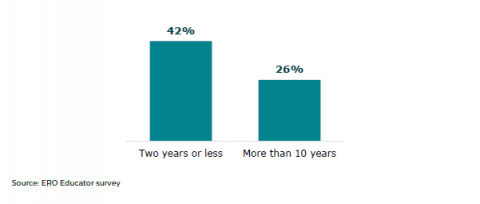
Source: ERO Educator survey
“It can't continue because our most vulnerable young people, they're just falling through the cracks. And Alternative Education providers are just closing down left, right and centre. I know of two that closed down last month because they can't provide that funding. Where do those young people go? ... And when we're working with the most vulnerable in society, they need the most support.” - Alternative Education provider
“Why do we need community funding when it is an educational provision? If [Alternative Education] was funded appropriately, we would have qualified teachers in [Alternative Education].” - Alternative Education Consortium leader
In interviews, contract-holding school leaders told us providers had closed due to being unable to ‘keep the lights on’ or find staff. In one region there had been six different providers in eight years due to being unable to find sufficient grant money to continue to operate.
“We lost a provider last year who was offering 30 Alternative Education places. Prior to this provider another provider had found it not financially viable, they had challenges with both management and staff before finally leaving.” - Alternative Education Consortium leader
6. Connections and support for staff
Access to specialist support
Educators told us it is challenging to meet young people’s complex needs and it is difficult to access support services.
Only 12 out of 21 providers (57 percent) said they had access to learning needs support, and only 13 out of 21 (62 percent) have access to behaviour support for young people who need it.
In our interviews with providers we heard that while some schools invite Alternative Education staff to join them for staff training, share resources, and meet regularly about young people, many have little interaction with contract-holding schools outside referrals and reporting cycles.
Providers shared that, until recently, it was almost impossible for them to access Resource Teachers: Learning and Behaviour (RTLB) and behaviour support services. The updated guidelines have made the access to RTLB support explicit, allowing providers to access support for young people enrolled in Years 9 and 10, but it is too soon to see the effects of this.
“We do not have access to RTLB or learning support specialists…we cannot access PB4L [Positive Behaviour for Learning] PLD.” - Alternative Education leader
Alternative Education providers experience delays in accessing other community supports for young people too. It can be difficult to get young people the mental health support they need, for example from counsellors, psychologists, or addiction services.
Engagement with Māori
One-third of Alternative Education providers never meet with hapū or iwi.
While the relationship and engagement with parents and whānau was identified as a strength by Alternative Education providers, consortium and school leaders identified the need to increase Māori language and cultural knowledge-based provision.
Leaders and educators told us they want more Māori provision that values kaupapa Māori (Māori ways of doing and being), mātauranga Māori, and te reo Māori. While there are some runanga (Māori council), and iwi (Māori tribe) based kaupapa Māori providers, their provision is limited to only a few regions in Aotearoa New Zealand.
“So now Ngāti Maru, who is one of the local iwi, are really interested and are doing a pilot programme in South Taranaki with one of the small Alternative Eds around, you know, cultural identity. And so I have asked if they would like to pilot it here as well… so he is putting together a plan.” - Alternative Education provider
“… we have had programs that are Māori based actually, and they have fallen over to, you know, just because of the money. Yeah, you know, we had a really good program that mainly worked with our Māori boys, strong Māori model, Māori male tutors, and it couldn't sustain itself because financially it became unviable.” - Alternative Education provider
One in three Alternative Education providers (six out of 18) have never met with their local hapū or iwi.
Maintaining cultural knowledge-based provision is difficult for many providers. We heard about Māori providers coming and going due to financial limitations.
“to be able to run really, really robust cultural programs … but to be able to bring in experts, you need to afford, to be able to pay them. And they're so stretched to capacity as it is anyway.” - Alternative Education provider
7. Accountability for delivery and outcomes
While schools maintain responsibility for ensuring young people’s outcomes while they attend Alternative Education, they have limited involvement or oversight of young people’s learning and progress.
Providers told us they report back to the schools young people in Alternative Education are enrolled at on young people’s attendance and progress, however there is little meaningful interaction outside of referral and reporting cycles.
Variable data practices and system level inefficiencies makes tracking and monitoring young people in Alternative Education, and their outcomes, difficult.
Alternative Education providers are expected to report back regularly to their contract-holding schools, who then report back to the Ministry of Education. There are limitations to this data, meaning there is little system-level information about the young people in Alternative Education or their outcomes, and the quality of this is poor.
Alternative Education providers told us the only outcome they saw of sending in required reports was that it triggered their next round of funding. Some had noted problems such as increasing waitlists in their reports to the Ministry of Education, and these were not acknowledged.
“It's really hard to report on a waiting list… To be able to show that we've got a greater need than what we have in our space… I just write it [the amount of young people on the waiting list] because we have like… a monthly… report that goes back to the Ministry on our roll.” - Alternative Education Consortium Leader
A young person who was not reengaged in learning and exited Alternative Education with negative outcomes |
Liam loves to cook, and was happiest in his food technology class. Unfortunately, he was suspended from his secondary school more than five times. Despite doing the one‑week and the six-week courses offered by the Activity Centre, he was finally excluded by the secondary school he was enrolled in. Liam started attending the Alternative Education programme as a 14-year-old and was moved around between different Alternative Education providers due to persistent behaviour and attendance issues. At age 15 he was offered employment by his uncle as a road works helper, and was given early leaving exemption from education. Unfortunately Liam has not been able stay in employment because of his drug and alcohol related behaviour and is currently not in education, employment, or training. He is currently also known to the Police and the Youth Justice system. |
8. Options available for young people who are the most disengaged from learning
Options other than Alternative Education
There are few options for young people if they cannot access Alternative Education.
Alternative Education is not suitable for all young people. A provider may not accept a young person onto their programme if:
- they do not have an available place
- the programme offered by the provider is not suitable for the young person
- in some cases, they are in Oranga Tamariki care and do not have a stable care placement.
Alternative Education also does not work out for all young people – some young people do not show up and others can be asked to leave.
Young people who cannot attend school and cannot attend Alternative Education have very limited community- or social service-based options to support them to continue in vocational training or find employment. Two-fifths of provider leaders (eight of 21) do not have or do not know of other types of Alternative Education provision in their region.
When young people are excluded from Alternative Education and are still required to be in compulsory education. Te Aho o Te Kura Pounamu (the Correspondence School) is one of the options, along with home schooling.
“For young people who fall off, fall off the roll and we don’t know where they’ve gone, obviously there isn’t any follow up when that happens. I wish it didn’t, but it does. The transience is an ongoing challenge and will remain so”. - Alternative Education Consortium Leader
Lack of options and long wait times can increase disengagement.
Educators, provider leaders, and contract-holding school leaders told us there has been a large increase in demand for Alternative Education places. In some areas, this has led to schools no longer seeking support from Alternative Education. Five out of the eight schools who reported they do not use Alternative Education do not do so due to a lack of availability of places.
While there is no data on wait times, we heard from providers that wait times are long and, in many cases, young people are left to self-direct learning at home until a space becomes available. This further entrenches their disengagement from learning, and makes it harder for young people to build a habit of regular attendance when spaces do become available.
Conclusion
The current model of Alternative Education does not set providers or young people up for success. It is inadequately resourced, meaning educators are often untrained, and lack the skills and resources to support young people’s educational achievement. Providers’ isolation from each other, little integration with contract-holding schools or the schools young people are enrolled at, and difficulty accessing wider community supports makes it challenging for them to meet young people’s needs. Staff are isolated from others, and so lack professional support. The complexity of young people’s needs means education is often not a priority, and young people in Alternative Education do not achieve good outcomes.
Part 8: What enables success for the few young people in Alternative Education who experience it?
While most young people in Alternative Education have a positive experience, few go on to achieve successful short- or long-term outcomes. When young people (exceptionally) do succeed at Alternative Education, it is due to the elements of the model that do work. Small class sizes, having the same educator through the day, having something ‘different’ to school, and caring and committed staff helped the young people experience success.
This section describes the aspects of the model and the practice that support young people to achieve success.
How we gathered information
In all Alternative Education providers we visited, and through all interviews with young people, parents, educators and leaders, we asked about what helped young people experience success at Alternative Education and beyond.
Across the model and the practice, we identified four areas that work well to support young people’s engagement in learning, and outcomes. These are:
- small class sizes
- having the same educator throughout the day
- the flexibility to provide a tailored education, different to school
- caring staff, committed to young people’s success.
This section sets out the parts of Alternative Education it is important we keep, as they help young people experience success.
What we found: An overview
Small class sizes allow young people to know their peers and be known by their educators, which increases their sense of safety and belonging. Classes in Alternative Education are typically smaller than those in secondary schools, usually up to 15 young people per class. The smaller educator/young person ratio, of around one educator to up to 10 young people, means educators know young people well.
Having the same educator through the day means young people can develop strong relationships with them, which supports their engagement in learning. Unlike secondary schools, where young people change teachers for each subject, young people in Alternative Education usually have the same educator throughout the day. Educators know young people well, and young people feel cared for and supported, helping the young people focus on their learning.
Alternative Education providers have the flexibility to provide a different education on a site separate from school. Many young people in Alternative Education have negative experiences of school. Alternative Education works well when it looks and feels different to school. For the young people who have been excluded from school and have received trespass notices from their school, Alternative Education provides education on sites separate from schools.
Staff with experience, aptitude, and commitment to working with these young people are at the core of young people’s positive experiences and outcomes from Alternative Education. Positive, trusting relationships between young people and their educators are critical to their engagement and enjoyment of learning. While the majority of educators in Alternative Education are not registered teachers, they care deeply about the young people they work with. We saw the best learning outcomes when providers paired trained teachers with skilled youth workers.
1. Small class sizes
Most young people appreciate the small class size and support they receive from the educators because of the low educator/learner ratio and one-to-one attention. Some also appreciated lower noise levels than their old school. Secondary school classrooms often have double the number of young people, typically between 17 and 30 learners.49
Small class sizes and seeing the same staff and classmates everyday provides stability for young people who may not have much stability in other areas of their life. It is also beneficial for some young people with disabilities, such as those who have sensory processing difficulties.
A risk with the small class sizes and close relationships with peers is that antisocial behaviour may spread easily. In particular, 13-year-olds may be unduly influenced by their older classmates.
“I know all these kids. And there’s only like two teachers… So it’s actually easier for me, and I actually do good with a little group of people.” - Young person attending Alternative Education
“They write about how this is the first place where I felt like I belong and, like, somebody cares. And that sense of belonging is, I think, what makes Alternative Education work is that, that it has to be a place where they feel like they belong and that they matter and that they're a part of something. Because at school they felt disconnected.” - Alternative Education educator
| A young person who could sustain the positive effect of Alternative Education and has followed an alternative path to positive outcomes |
Hannah loves repairing bikes, and mountain biking in her local forest. She started attending Alternative Education as a 15-year-old because of her chronic attendance and behaviour issues at school, which included getting into fights after school. Hannah felt safer at Alternative Education and started attending more regularly. She was also supported by the Alternative Education provider to access anger management and counselling services. Hannah enjoyed the ‘taster’ courses her educators took her to before she turned 16, to help her understand the range of courses she could access as part of the Youth Guarantee programme. She really liked the hair and beauty course and enrolled in it with the help of her Alternative Education providers, who also supported Hannah to get her driver’s license. Hannah successfully completed her Level 2 Certificate in Foundation Skills, a full-time 20 week course, and the full-time 34 week Certificate in Hairdressing Level 3 course. She was successful in getting a job as a hair salon assistant straight after completing her course. Hannah continues to be in full time employment and hopes to do the Level 4 course in Hair Styling in a few years and sees herself as an emerging hairstylist. |
2. Having the same educator throughout the day
Young people told us in interviews that getting to know their educators, and to be known by them, is fundamental to their positive experience of Alternative Education. A relational approach to learning, where the educator and young person build a strong relationship, is valued by young people and they have better experiences when it is prioritised by educators and providers.
For many young people in Alternative Education, hardship in their lives, such as trauma, poverty, and isolation has played a large part in their disengagement from school. Feeling heard, understood, and cared about is particularly important for them.
While having the same educator throughout the day provides opportunities for strong relationships, it may create challenges for providers to provide young people with learning opportunities across the full breadth of the curriculum.
“Here it’s small, I can actually ask for help and interact with all the tutors.” - Young person attending Alternative Education
3. Flexibility to provide a tailored education, separate from school
Learning in a way that looks and feels different to school helps young people overcome negative feelings about school.
Many young people in Alternative Education have had negative experiences of school, some to the point they experience extreme anxiety or fear about attending school. Others have been trespassed from school property and are not allowed on the school site.
Young people, their parents, Alternative Education providers, and school leaders all told us it was important that Alternative Education is different to school.
Some places we saw that supported young people to engage deeply in learning include:
- a downtown venue that also operated as a youth drop-in centre, where young people sat on couches around a coffee table while having learning conversations with their educators
- a suburban site, removed from foot traffic, where young people had access to outdoor areas as well as a variety of different spaces to learn in.
Some Alternative Education providers give young people ongoing support as they move to their next step after Alternative Education.
A few providers check up on young people when they leave Alternative Education; this is done unofficially to see how they are doing. Only one provider we talked to has an official process where young people are provided with pastoral care for up to two years after they leave Alternative Education. This process is not funded and relies on philanthropic funding.
Some young people return to the Alternative Education provider seeking support for their wellbeing needs, such as talking to the Police or navigating family issues.
4. Caring staff, committed to young people’s success
Young people told us how important it was that their educators care about them, and ‘get’ where they are coming from.
We saw educators who were passionate about supporting young people to achieve good outcomes. Many discussed their own similar experiences, and how they relate to the young people they work with. This is important for young people. We heard how young people appreciated seeing educators who had ‘been there’ – educators who had once been Alternative Education learners themselves.
Whānau of young people in Alternative Education also appreciate the personal and caring relationships educators have with them, referring to them, and the wider Alternative Education team, as family.
The consideration staff have for young people in Alternative Education fosters an engagement in learning that many in this group have not experienced before. We saw the best learning outcomes when providers paired trained teachers with skilled youth workers.
“You feel loved here.” - Young person attending Alternative Education
“My boys never miss, they come every day… They’re up every morning and they’re just like keen as to go.” - Parent of two young people attending Alternative Education
Culturally responsive teaching for Māori young people helps them feel respected.
Alternative Education provides relationally-focused learning where young people build relationships with their providers and educators. This helps Māori young people feel more culturally safe. Māori young people feel their culture is respected in Alternative Education (91 percent); much more than at their old school (76 percent).
Many experience less racism at Alternative Education compared to their school.
Figure 46: My culture is respected at Alternative Education compared to at old school: Māori young people
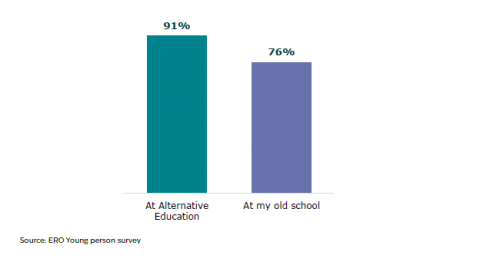
Source: ERO Young person survey
Figure 47: Someone has been racist to me at Alternative Education compared to at old school: Māori young people
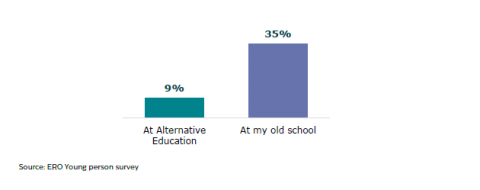
Source: ERO Young person survey
We heard from young people and parents about the whānau-like relationships with educators and the feeling of whanaungatanga (family-like relationships) they experience at their Alternative Education. Taking the time to build and sustain quality relationships helps improve attendance and engagement in learning for young people in Alternative Education. Whānau are more positive about talking to educators at Alternative Education about their child’s learning, compared to teachers at their previous school.
Conclusion
The model of Alternative Education needs to be completely reformed, however, there are elements important to keep as they support some young people to succeed. The flexibility of the model, allowing for tailored, localised provision is a strength. It is critical that young people learn in small classes, with consistency in the educator working with them. Strong relationships, and practice that recognises and values each young person’s culture and identity are fundamental to young people’s success.
Part 9: Findings and areas for action: How can we improve outcomes for young people in Alternative Education?
Alternative Education aims to provide a quality education to our most disengaged young people. While they have positive experiences, the teaching quality is poor and their outcomes are poor. This section sets out the findings, areas for action, and our recommendations for improvement.
In this evaluation of the quality of provision for young people in Alternative Education, we answered three key questions:
- Who are the young people in Alternative Education and what are their outcomes and experiences?
- How good is Alternative Education provision?
- What changes are needed to strengthen provision?
Our evaluation led to 10 key findings.
Finding 1: Young people in Alternative Education are the most highly disengaged from education. Many are exposed to crime, violence and trauma, and just under a third have a mental health need. Many are in the Youth Justice system. They are 25 times more likely than other young people to have had a Family Group Conference.
Finding 2: Young people in Alternative Education are disproportionately Māori and male. Sixty-eight percent are Māori, and 63 percent are male. The number of females has increased recently.
Finding 3: Young people are referred to Alternative Education due to behaviour. Over a quarter have been suspended or excluded. They are also referred due to attendance issues, and alienation from school. Sometimes they are referred by Youth Justice or Oranga Tamariki.
Finding 4: These young people’s needs have not been identified and met early enough. They also have significant gaps in their learning, which have not been addressed. Waiting for a place at Alternative Education deepens the disengagement. This indicates that our education system is not currently set up with sufficient or the right range of provision to meet the needs of these young people.
Finding 5: While in Alternative Education these young people attend more, enjoy learning more, and feel safer. They have a stronger sense of belonging and improved behaviour. Sixty-seven percent enjoy learning in Alternative Education, and 93 percent feel safe.
Finding 6: When they move out of Alternative Education, only around one in four return to school. More than half do not go on to further training or employment. By age 20, almost 70 percent are receiving benefits.
Finding 7: Alternative Education does not provide good outcomes. These young people have significantly worse outcomes than other young people, worse even than very similarly disengaged young people with high needs. They are very unlikely to achieve an education qualification. Less than one in 10 achieve NCEA Level 2 or higher. As adults, they are much more likely to be receiving benefits and involved in the criminal justice system.
Finding 8: The current model of Alternative Education is inadequate to meet the level of need of these often highly disengaged young people, leading to worse outcomes than for other young people.
- Teaching is weak and teaching resources are inadequate.
- Facilities are often so run down they act as a barrier to learning.
- Funding is inadequate
- Funding limitations make it unviable for many providers, and provider and staff turnover is high.
- Providers are often isolated from other providers and schools, so they often lack access to broader education resources (e.g. careers advice, specialist subjects, sports) and professional teaching support.
- Providers cannot always access the broader wrap-around support young people need.
- Accountability for delivery and outcomes is weak.
Finding 9: When young people (exceptionally) do succeed at Alternative Education it is due to the elements of the model that do work:
- small class sizes
- having the same educator throughout the day
- the flexibility to provide a different education on a site separate from school
- having staff with experience, aptitude, and commitment to working with these young people, who act as positive role models.
These elements need to be combined with a model enabling quality education, wrap-‑around support, and a range of pathways.
Finding 10: Alternative Education is potentially a missed opportunity to change these young people’s life trajectories. They are often engaged and attending, but the current model of provision is failing to provide them with a quality education and may be contributing to poorer outcomes. The long-term costs for both the young person, their family, and broader society are very significant.
ERO is concerned that we are seeing a consistent pattern of education provision not meeting the needs of the young people with the greatest risk of disengagement and the highest needs. ERO’s previous evaluations of Te Aho o Te Kura Pounamu | The Correspondence School (2021) and education in residential care (2021) also found that there is inadequate education provision to meet the needs of the most disengaged young people.
In this section, we summarise the evidence across the report that supports these findings, and identify areas for action to address them.
Ten key findings
Finding 1: Young people in Alternative Education are the most highly disengaged from education. Many are exposed to crime, violence and trauma, and just under a third have a mental health need. Many are in the Youth Justice System. They are 25 times more likely than other young people to have had a Family Group Conference.
Young people in Alternative Education have significant mental health, disability and related needs, and have been involved in offending.
- Almost one in three (31 percent) of young people in Alternative Education have been referred to a specialist mental health service. This is more than four times more likely than the rest of the population.
- One in 12 (eight percent) of young people in Alternative Education have had a Family Group Conference in the Youth Justice system. This is 25 times more likely than the rest of the population.
- Young people in Alternative Education have high involvement with Oranga Tamariki. One in six (17 percent) of young people in Alternative Education have been in the care of Oranga Tamariki; nine times more likely than the rest of the population.
- Young people in Alternative Education have high levels of transience – one in five (21 percent) have moved schools three or more times before starting at Alternative Education. This is five times more than the rest of the population.
Finding 2: Young people in Alternative Education are disproportionately Māori and male, though the number of females has increased recently.
Māori and male young people are overrepresented in Alternative Education.
- Seven out of 10 (68 percent) young people in Alternative Education are Māori, compared to 24 percent outside of Alternative Education.
- Six out of 10 (63 percent) of young people in Alternative Education are male, compared to five out of 10 (51 percent) outside of Alternative Education.
In interviews, providers told us the number of females being referred to Alternative Education is increasing.
Finding 3: Young people are referred to Alternative Education due to behaviour. They are also referred due to attendance issues and alienation from school sometimes they are referred by Youth Justice or Oranga Tamariki.
Many young people in Alternative Education have a history of absenteeism, suspension, and exclusion due to behaviour issues.
- Many young people in Alternative Education have been suspended or excluded. More than one in four (28 percent) have been suspended or excluded at least once, which is 22 times more likely than other young people.
- Prior to starting in Alternative Education, two out of five (38 percent) young people in Alternative Education have been referred to Attendance Services. This is over five times more likely than the rest of the population.
Finding 4: These young people’s needs have not been identified and met early enough. They also have significant gaps in their learning, which have not been addressed. Waiting for a place at Alternative Education deepens the disengagement. This indicates that our education system is not currently set up with sufficient, or the right range of provision to meet the needs of these young people.
In the year before they start attending Alternative Education, young people in Alternative Education miss an average of 58 days of school. Educators told us that many young people are working at a level several years below their age – for example, at Year 4 or 5 level (age eight to 10), even though they are 13 to 16 years old.
Finding 5: While in Alternative Education these young people attend more, enjoy learning more, and feel safer. They have a stronger sense of belonging, and improved behaviour.
- Fourteen of 22 whānau report their young person attends Alternative Education more than they attended their previous school. There is no national attendance data for young people in Alternative Education.
- Three out of four (76 percent) young people in Alternative Education prefer to learn at Alternative Education.
- Four out of five (84 percent) young people in Alternative Education have an educator they like, and four out of five (83 percent) have someone who cares about them.
Finding 6: When they move out of Alternative Education, only around one in four return to school. More than half do not go on to further training or employment. By age 20, almost 70 percent are receiving benefits.
Over half of young people do not have a positive next step after Alternative Education.
- Only three in 10 (28 percent) young people who attend Alternative Education are attending tertiary education at age 18, and by age 24 this drops to one in 10 (11 percent).
- At age 24, almost two-thirds (63 percent) of people who had attended Alternative Education were receiving a benefit, compared to half of adults (51 percent) in the matched comparison group.
Finding 7: Alternative Education does not provide good outcomes. These young people have significantly worse outcomes than other young people, worse even than very similarly disengaged young people with high needs. They are very unlikely to achieve an education qualification. As adults, they are much more likely to be receiving benefits and involved in the criminal justice system.
- Less than one in five young people from Alternative Education achieve NCEA Level 1 or higher (18 percent), compared to nine out of 10 (88 percent) other young people.
- Less than one in 10 young people from Alternative Education achieve NCEA Level 2 or higher (9 percent), compared to eight out of 10 (78 percent) other young people.
Finding 8: The current model of Alternative Education is inadequate to meet the level of need of these often highly disengaged young people, leading to worse outcomes than for other young people:
- Teaching is weak and teaching resources are inadequate
- Only one in five (19 percent) educators in Alternative Education are registered teachers.
- One in five (21 percent) educators reported they wanted more support in teaching literacy, and nearly one in four (23 percent) needed support in teaching numeracy.
- Only half (51 percent) of educators have the resources they need to do their jobs, and a quarter (24 percent) of Alternative Education providers do not have access to curriculum resources.
- We observed teaching of outdated and disproven ideas, resources that were not age appropriate, and saw a reliance on learning programmes that are not working for young people.
- Facilities are often so run down they act as a barrier to learning
- We visited 22 Alternative Education sites and found six operating out of poor quality or inadequate facilities.
- Funding is inadequate (lower than funding for other, less disadvantaged young people).
- Funding is inadequate. Budget 2023 recently allocated an additional $25.216 million over four years to Alternative Education, to increase the funding per place to $16,536. This is less than the funding in some small secondary schools.
- Funding limitations make it unviable for many providers, and provider and staff turnover is high.
- Forty-two percent of educators in Alternative Education have worked in Alternative Education for less than two years and, in one region, the contract-holding school had worked with six providers over eight years.
- Providers and contract-holding schools reported many providers closed due to it being financially unsustainable to continue operating.
- Providers are isolated from other providers and schools, so they often lack access to broader education resources (e.g., careers advice, specialist subjects, sports) and professional teaching support.
- Many reported very little interaction with contract-holding schools or schools young people in Alternative Education are enrolled at, outside referral and reporting cycles.
- It is a challenge to access specialist teachers, for example science, technology or language teachers, and the specialised spaces for learning.
- Providers cannot always access the broader wrap-around support young people need.
- Only 12 out of 21 providers have access to learning needs support, and 13 out 21 have access to behaviour support.
- Many reported difficulty accessing other community-based supports, such as counselling and mental health support for young people.
- Accountability for delivery and outcomes is weak.
- There is little system-level data for young people in Alternative Education, and little is known about young people’s outcomes.
- While schools maintain responsibility for ensuring young people’s outcomes while they attend Alternative Education, they have limited involvement or oversight of young people’s learning and progress.
Finding 9: When young people (exceptionally) do succeed at Alternative Education it is due to the elements of the model that do work.
- Small class sizes
- Young people reported the smaller class size at Alternative Education was a critical element in their feeling safe and able to learn.
- Having the same educator throughout the day
- Getting to know their educators and be known by them meant young people felt cared for and supported.
- The flexibility to provide a different education separate from school
- Young people engaged enthusiastically when their learning was meaningful to them. Their poor experiences of school mean it is important that Alternative Education is different to school.
- Having staff with experience, aptitude, and commitment to working with these young people, who act as positive role models
- Young people told us it was important to them that their educators cared for them and understood them.
These elements need to be combined with a model enabling quality education, wrap-around support, and a range of pathways.
Finding 10: Alternative Education is potentially a missed opportunity to change these young people’s life trajectories. They are often engaged and attending, but the current model of provision is failing to provide them with a quality education and may be contributing to poorer outcomes. The long-term costs for both the young person, their family, and broader society are very significant.
Alternative Education provides an opportunity to change life trajectories. The failure to do so is very expensive, with a very high proportion of young people moving on to offending, benefit receipt, and experiencing poor health.
Five areas for action
Based on this evaluation, we have identified five areas to improve the quality of provision for young people in Alternative Education and, from there, their outcomes.
Area 1: Better identify and meet the needs of these young people before they become disengaged, and increase the number who are able to stay and succeed in mainstream schooling.
Area 2: Make sure there are a range of effective options (of different type, intensity, and duration) available for those young people who are not thriving in the school setting, and that there are clear, consistent, and rigorous gateways so that young people are matched to provision that best meets their needs.
Area 3: As part of this set of options, reform the ‘Alternative Education’ model of provision so that there is a new model that is designed to meet both the education and broader needs of the most disengaged young people who need an alternative to mainstream schooling.
Area 4: Put in place the support needed for successful pathways and transitions from ‘Alternative Education’ into further education, training, or employment.
Area 5: Strengthen accountability and monitor how well provision is meeting the needs of young people who are in ‘Alternative Education’.
Action Area 1: Better identify and meet the needs of these young people, before they become disengaged and increase the number who are able to stay and succeed in mainstream schooling.
Young people often end up in Alternative Education due to behaviour issues, acting out the trauma and violence that is part of their lives. They have mental health needs that are not addressed and a long history of attendance issues, alienation from school, and requests for support made by Youth Justice and Oranga Tamariki.
More needs to be done earlier to support schools to catch young people early in their pathway to disengagement, and to find ways to help young people stay engaged and to continue in school, therefore reducing the number of young people in Alternative Education. To achieve this ERO recommends:
Recommendation 1: The Ministry of Education provide guidance on how to effectively identify young people most at risk of disengagement, and support schools to better identify these young people.
Recommendation 2: Having identified young people most at risk of disengagement, the Ministry of Education support schools to act early to enable them to stay and succeed in school, including increasing awareness of:
- the predictive risk factors for being referred to Alternative Education
- models of practice and intervention that support young people’s continued engagement in education
- where and how flexibility can help with inclusion for young people at risk of disengaging
- how to access support to address issues, including connecting with other services and programmes that provide more intensive support and links to other tools and resources that may help.
Recommendation 3: ERO and the Ministry of Education identify and share with schools best practice in managing challenging behaviours in the classroom to enable more young people to stay in school.
Implementing these recommendations will help schools reduce the number of young people at risk of disengaging from learning, by responding early and effectively.
Action Area 2: Make sure there are a range of effective options (of different type, intensity and duration) available for those young people who are not thriving in the school setting, and that there are clear, consistent, and rigorous gateways so that young people are matched to provision that best meets their needs.
For too many young people, Alternative Education is the only choice, not the right choice. The decision is made because of behavioural issues, attendance issue, and referrals made by Youth Justice and Oranga Tamariki. It is not made because the school, the young person, and their whānau all agree it is the best decision for their learning.
To make sure that Alternative Education is a deliberate and appropriate choice for young people, ERO recommends:
Recommendation 4: The Ministry of Education examine the range of options available for those young people who are not thriving in the school setting, how well they meet the range of needs and are complementary, and how clear and consistent the criteria for referral are.
Recommendation 5: To support decisions, made with whānau, on which education options are suitable for a young person, the Ministry of Education develop guidance for all schools that includes:
- the range of options for education outside of schooling
- the types of learners that each of the options are most suitable for
- how to access each of the options and eligibility requirements
- what is needed for good transitions into different education settings, including having a plan for information to follow the learners
- the role of all agencies in each of the options.
Implementing these recommendations will help schools, whānau and young people make an informed choice about whether Alternative Education is the right option for a young person.
Action Area 3: As part of this set of options, reform the ‘Alternative Education’ model of provision so that there is a new model that is designed to meet both the education and broader needs of the most disengaged young people, who need an alternative to mainstream schooling.
While we need to reduce the numbers of young people who need Alternative Education, we also need to recognise there will always be a need for Alternative Education programmes. There are young people for whom school is not the right place because of their behaviour, mental health or learning needs.
But the current model is failing young people. It is inadequate to meet the needs of the most disadvantaged young people. They need a place that:
- sets up young people for later success, so that they can learn, achieve and go on to meet their education and employment goals
- is separate from schools, so that young people can attend and feel safe
- continues to create the sense of belonging that current providers do, so that young people want to attend
- exposes young people to positive social influences, including role models of people like them who have gone on to succeed
- keeps the successful components of small class sizes, and one on one teaching so that young people are able to learn.
Recommendation 6: The Ministry of Education develop a clear national model and set of standards for high quality ‘Alternative Education’ provision that includes:
- funding that is sufficient to meet the depth and complexity of needs of this group
- a funding model that allows for greater oversight and accountability
- a national model of teaching practice that is based on the evidence of teaching approaches that work for young people who are the most disengaged from learning
- a requirement for providers to have qualified, registered teachers
- a requirement for small class sizes and continuity of teacher or educator
- access to the broad range of education expertise and resources across education providers so young people can access education programmes and pathways that match their interests
- skilled support workers to provide wrap-around support for the young people and to broker access to specialist support to meet young people’s broader needs
- kaupapa Māori approaches that enable Māori young people to succeed as Māori.
Recommendation 7: The Ministry of Education to ensure all current and future ‘Alternative Education’ provision has suitable premises and facilities – in line with the expectations for other learning environments.
Recommendation 8: The Ministry of Education supports teachers in Alternative Education, with a lead of professional practice, curriculum resources tailored for young people in Alternative Education, and facilitated professional networks.
Recommendation 9: The Ministry of Education, Ministry of Health, Oranga Tamariki, Whaikaha | Ministry of Disabled People, and Ministry of Social Development work together to ensure young people in ‘Alternative Education’ are a priority for the specialist support they need.
Reforming the model of Alternative Education will ensure Alternative Education providers have the funding, resources, support, and skills to meet young people’s needs.
Action Area 4: Put in place the support needed for successful pathways and transitions from ‘Alternative Education’ into further education, training or employment
Alternative Education can change life pathways, but young people cannot go from a high‑support model like Alternative Education, to independent learning on their own. Many of the gains in re-engagement and improved behaviour are lost.
To support young people as they move on from Alternative Education, and become established in positive pathways, ERO recommends:
Recommendation 10: The Ministry of Education, Tertiary Education Commission, Ministry of Social Development, Whaikaha | Ministry of Disabled People, and Oranga Tamariki review the transition and ongoing support for young people in ‘Alternative Education’ to ensure young people have a planned and supported pathway, with sufficient pastoral and learning support, to make a successful transition into further learning or work.
Implementing this recommendation will help young people embed the positive steps they have made and move on to more positive future outcomes.
Action Area 5: Strengthen accountability and monitor how well provision is meeting the needs of young people who are in ‘Alternative Education’
Underlying many of the issues, we found a lack of accountability. Information on progress was sent on to contract-holding schools, who sent it to the Ministry of Education.
To make sure there is adequate, appropriate information about young people in Alternative Education, their needs and outcomes, so that Government can be assured of the quality of provision, ERO recommends:
Recommendation 11: The Ministry of Education actively monitor the quality of provision in ‘Alternative Education.’
Recommendation 12: The Ministry of Education report annually on the education experiences and outcomes for young people in ‘Alternative Education,’ including:
- number of young people referred to ‘Alternative Education’
- wait times for entry to ‘Alternative Education’
- number of young people who receive a place and go on to attend ‘Alternative Education’
- attendance of young people in ‘Alternative Education’
- achievement of young people in ‘Alternative Education.’
Recommendation 13: The Ministry of Education ensure ‘Alternative Education’ providers and contract-holding schools collect and report reliable data on young people’s enrolment, education outcomes and destinations.
Recommendation 14: The Ministry of Education reports back to the Minister of Education, and Ministers with responsibility for Oranga Tamariki and Youth Justice, on progress made in response to these recommendations by June 2024.
Together, these recommendations will allow Government to know how well provision is meeting the needs of young people in Alternative Education, and target support where it is needed most.
Conclusion
In 2011, ERO reported that Alternative Education was not adequately supporting young people to succeed. Twelve years on, we continue to see the system failing to meet the needs of our most disadvantaged young people. The cost of this is high, both for the young people and wider society. Reengagement in education provides the greatest protective factor, and we have made recommendations to improve the quality of education that young people in Alternative Education receive.
Part 10: Next steps
ERO evaluated the quality of provision for young people in Alternative Education. We identified 10 key findings and five areas for action. The recommendations outlined under each area for action require development and approval from Ministers. We propose relevant agencies report back to Ministers by June 2024.
ERO last evaluated the quality of provision in Alternative Education in 2011. At that time, we found Alternative Education providers and schools were not working well together to support young people’s learning, and reengagement in education or other positive pathways.
Disappointingly, this is still the case. The model of Alternative Education does not enable high quality practice, and is insufficient to meet the needs of our most disadvantaged group of young people.
Implementing the recommendations
The recommendations outlined in Part 9 are high level and require a focussed work programme. We recommend the agencies involved report back to Ministers on progress by June 2024.
To support this, ERO will:
- identify and share best practice in managing difficult behaviours in the classroom to enable more young people to stay in school
- maintain our focus on equity and excellence for all young people in Aotearoa New Zealand throughout our work.
For our young people in Alternative Education, we know that education can turn their lives around and improve their outcomes. It is critical that we do better.
Appendix 1: Methods
Our evaluation questions
This evaluation looked at education provision for young people who attend Alternative Education. We answered three key questions:
- Who are the young people in Alternative Education and what are their outcomes and experiences?
- How good is Alternative Education provision?
- What changes are needed to strengthen provision?
Mixed methods approach to data collection
This evaluation used a complementary mix of quantitative and qualitative data sources to ensure breadth and depth in examining the key evaluation questions:
- ensuring breadth to provide system judgement on the key evaluation questions and a national picture through:
- online surveys of a sample of Alternative Education providers (providers and educators)
- online surveys of a sample of contract-holding schools and schools young people in Alternative Education may be enrolled at
- online surveys of young people in Alternative Education and their whānau
- interviews with key system informants
- literature review, administrative data, and interviews with key informants and experts.
- statistical analysis of administrative data collected by government agencies over the course of the lives of a large group of young people in Alternative Education
- ensuring depth in understanding what good looks like and what needs to improve, through:
- interviews with Alternative Education providers and educators
- interviews with young people from Alternative Education and their whānau
- interviews with leaders at contract-holding schools and schools young people in Alternative Education are enrolled at
- site visits.
Provider interviews and site visits
A sample of 11 contract-holding schools and their sites across the country were invited to participate in the case study component of this evaluation. The interviews were conducted by ERO’s team, which included those with specialist experience in reviewing quality practice.
We visited:
- Five services located in the Auckland Region
- Three services located in the Waikato Region
- One service located in the Gisborne Region
- Five services located in the Wellington Region
- Four services located in the Canterbury Region
- Four services located in the Otago region
The interviews were guided by semi-structured questions that were developed from the domains and indicators on quality practice for young people in Alternative Education. Based on analysis of key documents and interviews with key staff, the evaluation team assessed the quality of provision against 53 indicators across 12 domains. This assessment led to a description of how the provider was performing on each domain and indicator.
This helped the evaluation team identify examples of good practice and to understand what the key contributing factors were. Similarly, the team was able to identify examples of issues and challenges that providers were facing and understand the main contributing factors.
Interviews with young people in Alternative Education
We conducted interviews with 53 young people. Each interview was led by two evaluators.
The young people were nominated by the providers who participated in the case studies.
Interviews with whānau and caregivers
We conducted interviews with 19 whānau and caregivers of young people in Alternative Education. Nearly all interviews were led by two evaluators. Nearly all of the interviews were conducted remotely over the phone (depending on the preference of the whānau member).
The families were nominated by the providers who participated in the case studies.
Interviews with contract-holding school leaders
We conducted interviews with 27 leaders of contract-holding schools and 17 interviews with school leaders. Each interview was led by two evaluators.
Interviews with providers
We conducted interviews with 24 Alternative Education providers, and 41 educators. Nearly all interviews were led by two evaluators.
Surveys
We invited 86 contract-holding schools to participate in online surveys, and send surveys onto the Alternative Education providers they contract.
We used the publicly available information on the Ministry of Education site Education Counts to obtain email contacts for all contract-holding schools. An email inviting contract-holding schools, providers, educators, young people and their whānau was sent to those addresses, with a request for the relevant information to be passed to each respondent.
Provider surveys
In March 2023, we received survey responses from:
- 22 Alternative Education providers
- 43 Alternative Education educators
The profile of the respondents from the providers and educators who responded to the survey in March 2023 is:
- Ethnicity: 68 percent were Pākehā, 38 percent were Māori, 12 percent were Pacific, none were Asian, 2 percent were other, and 3 percent did not know/preferred not to say.
- Region: 29 percent were from Auckland, 9 percent were from Waikato, 9 percent were from Bay of Plenty, 9 percent were from Taranaki, 6 percent were from Manawatu, 6 percent were from Wellington, 6 percent were from Southland, 5 percent were from Otago, 5 percent were from Canterbury, 5 percent were from Nelson, 3 percent were from Marlborough, and 2 percent were from West Coast.
School surveys
In March 2023, we received survey responses from:
- 84 leaders of schools young people in Alternative Education may be enrolled at
- 44 contract-holding school leaders
the profile of school leaders who responded to the survey in March 2023 is:
- Ethnicity data was not collected.
- Region: 19 percent were from Auckland, 13 were from Waikato, 11 percent were from Canterbury, 10 percent were from Manawatu, 10 percent were from Wellington, 6 percent were from Bay of Plenty, 6 percent were from Taranaki, 5 percent were from Northland, 4 percent were from West Coast, 4 percent were from Otago, 3 percent were from Tasman, 2 percent were from Nelson, 2 percent were from Marlborough, 2 percent were from Southland, and 1 percent were from Gisborne.
Young people and whānau surveys
In March 2023, we received survey responses from:
- 124 young people from Alternative Education
- 23 whānau and caregivers
Profile of young people and whānau who responded to the survey in March 2023:
- Ethnicity: 79 percent were Māori, 56 percent were Pākehā, 19 percent were Pacific, 5 percent were Asian, 7 percent were other, and 2 percent did not know, or preferred not to say.
- Region: 22 percent were from Auckland, 11 percent were from Manawatu, 10 percent were from Bay of Plenty, 8 percent were from Taranaki, 8 percent were from Nelson, 8 percent were from Taranaki, 8 percent were from Canterbury, 7 percent were from Waikato, 2 percent were from Southland, 1 percent were from Northland, and 1 percent were from Marlborough
Interviews with sector experts, stakeholders
Five interviews were conducted with key experts and stakeholders in the sector including:
- Ministry of Education: Learning Support Directorate, Curriculum, Learning Support Manager in one region
- one early education specialist
- one prominent academic.
Analysis of administrative data
As noted elsewhere in the report, there is a lack of systematic administrative data on young people in Alternative Education.
The Social Wellbeing Agency undertook a comprehensive statistical analysis of the lives of more than 23,000 young people in Alternative Education. This included a focus on their characteristics, past experiences, and future outcomes, based on administrative data collected by government agencies over the course of their lives. For more details on the method of this statistical analysis, see the separate technical report (SWA, 2023).
These results are not official statistics. They have been created for research purposes from the Integrated Data Infrastructure (IDI) which is carefully managed by Stats NZ. For more information about the IDI please visit https://www.stats.govt.nz/integrated-data/ .
The results are based in part on tax data supplied by Inland Revenue to Stats NZ under the Tax Administration Act 1994 for statistical purposes. Any discussion of data limitations or weaknesses is in the context of using the IDI for statistical purposes, and is not related to the data’s ability to support Inland Revenue’s core operational requirements.
Analysis, sense-making, and testing of recommendations
The interview data and open-ended comments from surveys were analysed and coded to identify key themes. The quantitative survey data was analysed using Survey Monkey, Excel and STATA.
Following analysis of the data from the survey and interviews, sense-making discussions were conducted to test interpretation of the results, findings, and areas for action with:
- ERO’s team of specialists in reviewing school practice
- Expert Advisory Group
- Steering Group
- An Alternative Education provider, and their young people
- Māori stakeholders
- Pacific stakeholders.
We then tested and refined the findings and recommendations with agencies and experts to ensure they were useful and practical.
Personas
We used what we learnt about young people in Alternative Education to develop ‘personas.’ These are not real people, but are based on typical descriptions of young people, their experiences in Alternative Education, and their outcomes.
Informed consent
Survey of young people in Alternative Education
Before young people agreed to complete the online survey, they were informed of the purpose of the evaluation and the survey. The information provided assurance that:
- participation was voluntary and anonymous
- neither the parent, their child, nor their provider will be named or identified in the reports
- parents can withdraw their consent to participate or choose not to answer any questions.
Young people indicated their consent by proceeding to complete the survey.
Interviews with young people
Young people who were invited to participate in an interview, were provided with an information sheet which explained the purpose of the interview and the evaluation. They were informed that their participation was voluntary, and that they could change their mind at any time. Any personal information they shared would be treated as confidential and the report would not identify them, or their provider. If the young person agreed to participate in the interview, we also asked their consent for the interview to be recorded. Young people’s parents or caregivers completed and submitted a written consent form for the young person’s participation to ERO.
Survey of parents and whānau
Before parents and whānau agreed to complete the online survey, they were informed of the purpose of the evaluation and the survey. The information provided assurance that:
- participation was voluntary and anonymous
- neither the parent, their child, nor their provider will be named or identified in the reports
- parents can withdraw their consent to participate or choose not to answer any questions.
Parents and whānau indicated their consent by proceeding to complete the survey.
Interviews with parents and whānau
Parents and whānau who were invited to participate in an interview, were provided with an information sheet which explained the purpose of the interview and the evaluation. They were informed that their participation was voluntary, and that they could change their mind at any time. Any personal information they shared would be treated as confidential and the report would not identify them, their child, or their child’s service. If the parent and whānau agreed to participate in the interview, we also asked their consent for the interview to be recorded. Parents provided their consent by completing and submitting a written consent form to ERO.
Surveys of school leaders, providers and educators
School leaders, providers and educators were informed of the purpose of the evaluation and the survey before they agreed to complete the survey. They were assured that their participation was voluntary and that their responses would be kept confidential. No details identifying themselves or their provider would be reported publicly. They could withdraw their consent to participate at any time or choose not to answer any questions, without any consequences to them.
Interviews with school leaders, providers and educators
School leaders, providers and educators were informed of the purpose of the evaluation before they agreed to participate in an interview. They were assured that their participation was voluntary and that they could withdraw consent to participate, and permission to use their information, at any time. They were told that the interviews were not an evaluation of their provider, and that they and their service would not be identified in the resulting national report. They were assured their information was confidential and would be kept securely subject to the provisions of the Official Information Act 1982, Privacy Act 1993, and the Public Records Act 2005 on the release and retention of information. Interviewees provided their consent to participate in an interview by completing and submitting a written consent form to ERO. Their verbal consent was also sought to record their online interviews.
Security
Audio files and notes from all interviews will be stored digitally for a period of six months after the research is completed. During this time, the data will be held in secure password protected project folders with access limited to project team members only.
Limitations of this evaluation
There are limitations to this evaluation.
In terms of scope, this evaluation:
- does not provide insight on the most disengaged young people
- does not examine specific intervention programmes
- does not make judgements about individual providers or teaching practice of individual educators
- does not examine needs assessment regarding health support
In terms of the evaluation findings:
- Responses from whānau, 13-year-olds, disabled young people and young people in Oranga Tamariki care were low.
Appendix 2: Roles and responsibilities in Alternative Education
| Who are they? | What do they do? | |
|---|---|---|
| Te Tāhuhu o te Mātauranga | The Ministry of Education | The government agency responsible for ensuring all young people receive the quality education they are entitled to. | The Ministry of Education manages Alternative Education contracts with contract holders. They:
|
Contract holders
| Typically managing schools, but can include iwi, hapū, or community organisations.
| Some provide Alternative Education themselves. Others contract out provision to third parties (e.g. churches, private training organisations). They must:
|
| The school the young person is enrolled in | The school a young person comes from when they go to Alternative Education. Any school with young people in Years 9 to 11 can be an enrolling school.
The young person is on their school’s roll while attending Alternative Education.
| The school the young person is enrolled in should provide pastoral care while the young person attending Alternative Education.
They should:
|
| Alternative Education provider | Schools, or community groups such as churches, non‑government organisations private training organisations, and iwi-based education providers can be Alternative Education providers, or they may support the provision (e.g. providing opportunities for young people outside of the classroom). Providers may be on-site at schools or based in the community, and may further subcontract elements of provision to others. | Providers work with the young people day-to-day, supporting their pastoral and educational needs. They:
|
Appendix 3: Indicators of quality used in this evaluation
To guide our judgments in this evaluation, we developed indicators for:
- Components of effective practice
- Components required for quality provision.
1. Components of effective practice
Alternative Education can help young people achieve educational success by:
- Addressing barriers to learning
- Re-engaging in learning
- Appropriate teaching (pedagogy) and meaningful curriculum
a) Addressing barriers to learning
Good practice in Alternative Education supports the young people and their whānau to address their barriers to learning in three ways.
| Indicators of good practice for reducing barriers to learning: |
|---|
|
b) Re-engaging in learning
Good Alternative Education practice should improve young people’s engagement and enjoyment of learning, and improve their attendance.
| Indicators of good practice for improved attendance and engagement include: |
|---|
|
c) Appropriate teaching (pedagogy) and meaningful curriculum
Quality teaching practices for disengaged learners are necessary for successful outcomes.
| Good practice for quality teaching and meaningful curriculum includes: |
|---|
|
2. Components required for quality provision
Using the evidence base, we developed indicators of good practice in six areas:
- Positive, nurturing relationships and environments
- Collaboration for effective transitions and pathways
- Effective leadership and ongoing improvements
- Workforce capacity and capability
- Culturally responsive practice
- Agencies working together
We then used these indicators of good practice to make judgments as to how well the model enables high quality provision for young people in Alternative Education.
a) Positive, nurturing relationships and environments
Learning environments impact engagement in learning. For young people who have experienced trauma, and disabled and neurodivergent young people attending Alternative Education, it is important learning environments are calm, orderly and encourage young people’s participation. Inaccessible and inappropriate environments can become significant barriers to learning.
| Good practice for positive, nurturing relationships and environments includes: |
|---|
|
b) Collaboration for effective transitions and pathways
Effective transitions provide a good foundation for success. Many of the young people in Alternative Education have instability in their lives. Transitions between settings need to be managed in a way that benefits and provides stability to the young person. Transitions are common area of vulnerability, where it is easy for things to go wrong and young people’s success to be at risk.
| Indicators of good practice for transitions into and out of Alternative Education include: |
|---|
|
c) Effective leadership and ongoing improvements
Effective leadership is a key component of success. Effective leadership shapes and influences processes, practices, effectiveness, and culture within education settings. The leaders have well-informed practices, shared goals, and high expectations. They can attract and retain skilled and effective staff members and support young people and their whānau aspirations.
| Indicators of good practice for leadership in Alternative Education includes: |
|---|
|
d) Workforce capability and capacity
The availability of a skilled workforce to meet the needs of young people in Alternative Education is paramount. Young people in Alternative Education have high levels of unmet need. A skilled and specialised workforce is necessary to meet their wellbeing and learning needs and enable success.
| Indicators of good practice for building workforce capability and capacity includes: |
|---|
|
e) Culturally responsive practice
| Good practice for culturally responsive practice includes: |
|---|
|
f) Agencies working together
Young people in Alternative Education often have complex needs, and are supported by a wide variety of people and agencies. It is critical that agencies and individuals work well together, towards shared goals for the young people in Alternative Education.
| Indicators of good practice for agencies working together include: |
|---|
|
Appendix 4: Key principles underpinning this evaluation
Te Tiriti o Waitangi and Ka Hikitia – Ka Hāpaitia Māori Education Strategy |
|
| The National Education and Learning Priorities |
|
| The Learning Support Action Plan |
|
| He Pikorua – Practice framework for the MoE and RTLB learning support practitioners |
|
Appendix 5: Annotated bibliography
| Addressing barriers to learning | Brooking, K., Gardiner, B., & Calvert, S. (2008). Background of students in alternative education: Interviews with a selected 2008 cohort. NZCER report for MoE This research project involved one-to-one interviews with 41 students attending five Alternative Education centres. The report identifies themes related to whānau and family, the influence of violence and of gangs in students’ lives, their educational pathways and experiences including in Alternative Education, and their strengths and aspirations. The majority of participants reported that their disengagement had begun at secondary school. The authors note that some structural and organisational features of secondary schools worked against students’ sense of belonging and engagement and limited the opportunity for teachers to develop effective relationships with these students. |
Bruce J (2014). Dis/engagement in secondary schools: Toward truancy prevention. Te Ora Hou Aotearoa This research presents the factors leading to disengagement in secondary school for young people with a history of truancy. By conducting interviews with youth, whānau and practitioners, researchers investigated ways to support young people toward engagement. The report highlights the need to work in a collaborative, multi-systemic manner in order increase engagement among young people and specifies approaches to be incorporated by practitioners and in policy. These include a focus on culturally relevant practice, effective whānau communication, informed practice, early intervention, and relating to young people. | |
| Re-engaging in learning | Mills, M and McGregor G (2014) Re-engaging young people in education: Learning from alternative schools. Routledge, London The book draws upon research of international relevance conducted in a range of ‘Flexible Learning Centres’ and ‘democratic schools’ in Australia and the UK; it suggests that improving the retention levels of young people in formal education will require schooling practices to change. Students who have become disengaged from mainstream schooling do re-engage in the learning process of many alternative schools, indicating that teaching practices and forms of organisation which work in alternative sites can also provide lessons for mainstream schooling, thereby encouraging a more socially just education system. “All young people have the capacity to learn and to enjoy learning; they do not ‘fail school’, rather, schools fail them.” |
NZSTA and Children’s Commissioner (2018) Education matters to me: Key insights – A starting point for the Statement of National Education and Learning Priorities (NELP) This report gave voice to children and young people across a range of engagement groups and services, including Alternative Education. It gives insight on the wants and needs of youth regarding their learning, highlighting what keeps them engaged. The youth involved spoke of feeling that their teachers respect them, understand them and emphasise their strengths as areas that would keep them engaged in their learning. Many children also touched on the importance of support from friends and whānau to keep them motivated. | |
| Appropriate pedagogy and meaningful curriculum for Māori learners | Berryman, M., & Bishop, R. (2016). A culturally responsive pedagogy of relations. The professional practice of teaching in New Zealand, 180-197. This article clarifies what the shared understanding of culturally responsive pedagogy is for Māori, through a unique New Zealand perspective. The authors, a group of teachers and researchers, share their insights after working in this field for nearly twenty years. They discuss the Treaty of Waitangi, and highlight the need to maintain equitable and respectful relationships. The authors also address the challenges and benefits of implementing culturally responsive pedagogy in classrooms. They stress the importance of acknowledging and valuing students’ cultural identities, building trust, and creating dialogic spaces for meaningful engagement. The article concludes by emphasizing the holistic development of students and promoting learning as an enjoyable and stimulating experience. |
| Positive, nurturing relationships and environments | Berryman, M., SooHoo, S., Nevin, A., Ford, T., Nodelman, D. J., Valenzuela, N., & Wilson, A. (2013). Culturally responsive methodologies at work in education settings. International Journal for Researcher Development. This paper illuminates the dimensions of culturally responsive methodology such as cultural and epistemological pluralism, deconstruction of Western colonial traditions of research, and primacy of relationships within culturally responsive dialogic encounters. |
Berryman, Mere, Dawn Lawrence, and Robbie Lamont. “Cultural relationships for responsive pedagogy.” SET: Research information for teachers 1 (2018): 3-10, NZCER Press This article brings clarity to how we have come to understand the term culturally responsive pedagogy both as grounded in cultural relationships and as responsive to the prior knowledge and experiences of the students themselves. These shared understandings come from many years of working and learning alongside teachers, leaders, students, and whānau. These learning relationships, and pedagogy, are discussed from a bicultural, mana ōrite perspective to bring a practical, theoretical, and unique Aotearoa New Zealand perspective to this work. | |
| Collaboration for effective transitions and pathways | Wayne Francis Charitable Trust and the Collaborative Trust (2021) Weaving connections – Tūhonohono rangatahi. Positive Youth Development in Aotearoa. Second Edition As part of the Trust’s strategic approach, the WFCT Youth Advisory Group developed criteria against which organisations and projects being considered for funding could be assessed as to whether they supported young people appropriately. In 2009, WFCT commissioned research which was originally published in the Youth Studies Australia journal, ‘Youth Work that is of value: Towards a model of best practice’. The Positive Youth Development in Aotearoa framework emerged from this research. |
Berridge, D., Dance, C., Beecham, J. & Field, s. (2008). Educating difficult adolescents: Effective education for children in public care or with emotional and behavioural difficulties. Jessica Kingslea Publisher: London, U.K. This book explores why educational achievements for children in care are significantly poorer than for the general school population. It evaluates the educational experience and performance of a sample of `difficult’ adolescents living in foster families, residential children’s homes and residential special schools for pupils with behavioural, emotional and social difficulties. The book’addresses factors such as the failure to prioritise education for children in care, placement instability and disrupted schooling. It investigates care environments, policy changes and young people’s background experiences in order to gauge the effectiveness of targeted initiatives. | |
Lambie, I., Krynen, A., Best, C., & Parkes, R. (2016). Care and Protection Secure Residences: A report on the international evidence to guide best practice and service delivery (p. 164). Ministry of Social Development. The report reviews the international evidence about best practice in the delivery of secure residential care for children and young people with significant care and protection needs. It summarises the key understandings and conclusions from the literature about what appears to work best for these young people. | |
| Effective leadership and ongoing improvement | Thornton, K. (2010). ‘School Leadership and Student Outcomes’: The Best Evidence Synthesis Iteration: Relevance for Early Childhood Education and Implications for Leadership Practice. Journal of Educational Leadership, Policy and Practice, 25(1), 31-41. This article reflects on the relevance of research surrounding school leadership and student outcomes, and its application to early childhood education. Specifically, the authors consider how pedagogical leadership can support goal setting, engagement with teachers’ theories of action and problem solving, and development of relational trust. |
Models of provision
| O’Brien, P., Thesing, A. and Herbert, P. (2001). Alternative education: Literature review and report on key informants’ experiences. Report to the Ministry of Education. This report combines the findings of a review of international literature and an exploratory study based on focus groups and a confirmatory telephone survey to identify indicators of quality Alternative Education, associated with five areas related to effective Alternative Education provision. The authors emphasise that standardisation of Alternative Education provision is neither realistic nor desirable (based on the quality indicators), highlighting the variety of different categories of alternative education provision internationally. They state that this variability does not prevent evaluation of successful indicators, noting that “whilst providers work differently within diverse frameworks, they actually strive for similar goals”. They do, however, state that the diversity of provision, which is crucial, makes evaluation difficult. The report details characteristics of successful Alternative Education programmes, including case studies of best practice models abroad, and examples of some New Zealand initiatives at the time. |
Bruce, J. (2020). Alternative Education workforce development in Aotearoa/New Zealand: Lessons from related sectors. This research focuses on the professional learning development (PLD) and workforce development in alternative education. It provides context for the current state of the Alternative Education workforce, and next steps for overcoming current barriers. The author explores factors impacting PLD and workforce development, and challenges to professionalism in related fields in order to inform next steps in Alternative Education. This research suggests the establishment of a national PLD strategy, and a central hub for Alternative Education and related settings to assist in knowledge and access. | |
Bruce, J. (2021). Understanding the alternative education workforce in Aotearoa/New Zealand This report follows the report Alternative Education workforce development in Aotearoa/New Zealand (Bruce, 2020) and focuses on Alternative Education educators’ experiences of professional learning and development (PLD). Cost, lack of staff cover, and lack of time were identified in the survey as the main barriers to accessing PLD, followed by a lack of relevant PLD opportunities. Few participants reported accessing PLD in curriculum-related topics. Participants expressed a desire to receive PLD through attendance at conferences, workshops, or learning in groups. Most participants were positive about the support they received from their pedagogical leaders, although this support was not necessarily categorised as PLD. | |
Schoone, A. (2016). The tutor: Transformational educators for 21st century learners. Dunmore Publishing This book explores the work of tutors in Alternative Education in Aotearoa New Zealand. It provides background on the introduction and development of Alternative Education provision, and the role of tutors within Alternative Education. It identifies key characteristics of tutors, using their words to describe how these characteristics are exhibited in their work with learners in Alternative Education. The book describes the pedagogical approaches used by tutors (as distinct from teachers), as well as their perspectives on what success and achievement looks like for learners in Alternative Education. The author makes a case for introducing the role (and accompanying training and qualification) of social pedagogues in the Aotearoa New Zealand context, similar to those found in Europe. | |
Adrian Schoone, Judy Bruce, Eileen Piggot-Irvine & Hana Turner- Adams (2022): How Alternative Education teachers embarked on getting to the heart of young people’s schooling stories, International Journal of Inclusive Education September 2022 issue,pages 1-17 This article explores the first phase of an action research project to investigate how teachers can meaningfully inquire about student’s schooling experiences. In this phase, six alternative education teachers planned inquiries to better understand their students’ schooling journeys. Each teacher employed different strategies, including relational one-on-one conversations, film production, art-based projects, podcasts, diary writing and talanoa. This first phase examples the critical and personalised outlooks Alternative Education teachers adopt when attempting to engage with their students. | |
Venet, Alex S. (2021). Equity-centered trauma-informed education. W. W. Norton & Company This book explores how teachers and leaders can implement equity-centered trauma-informed practices within schools. Venet describes key principles of equity-centered trauma-informed education and outlines key shifts required to bring about meaningful change. These shifts are presented in relation to decision-making and actions of both teachers and leaders, promoting structural change, both in the classroom and in school policy. | |
Bruce & Martin (2022). Combined activity centre/alternative education provision pilot research project: An initial report, June 2022 This is the first of three reports for the Ministry of Education evaluating a pilot project involving the combination of Activity Centre (AC) and Alternative Education (Alternative Education) provision at a single site. This initial report outlines the context of Activity Centres and Alternative Education, including background on the reducing number of providers in the pilot project region. Historically these have been separate forms of provision, with differing resourcing and staffing structures. The report identifiessome key organisational, management, and logistical challenges to combining Alternative Education and Activity Centre provision. The authors identify three different approaches to Alternative Education, namely: ‘holding pen’, ‘fix and return’, and ‘alternative pathway’. The report suggests that while policy and documentation around Alternative Education in Aotearoa New Zealand aligns with a ‘fix and return’ approach, the funding model has more closely fitted a ‘holding pen’ approach. | |
| Webber, M., & Macfarlane, A. (2020). Mana Tangata: The Five Optimal Cultural Conditions for Māori Student Success. Journal of American Indian Education 59(1), 26-49 This article explores social-psychological drivers for success in Māori students and offers the Mana Model to help Māori students thrive. The Mana model, which aims to combat impacts of negative societal stereotypes on Māori schooling success, was developed through surveys and interviews with senior Māori students deemed “successful”. This model is composed of five components, with the first components needing to be fulfilled before moving forward: Mana Whānau (familial pride), Mana Motuhake (personal pride and a sense of embedded achievement), Mana Tu (tenacity and self-esteem), Mana Ukaipo (belonging and connectedness), and Mana Tangatarua (broad knowledge and skills). This article concludes that a secure sense of mana, as fulfilled through the five components of the Mana model, can enable Māori students to achieve their academic aspirations in the face of negative societal barriers. |
Whitinui, P (2011) Kia Tangi te Titi- Permission to Speak: Successful schooling for Māori students in the 21st Century- Issues, Challenges and Alternatives. NZCER Press This book explores what constitutes successful schooling for Māori students in the 21st century by drawing together academic contributions from diverse fields of mätauranga (education), mätauranga hinengaro (psychology), whakaako hauora (health), akoranga takakau-ā-ora (sport and leisure) and others. The book aims to provide a critical, reflective and forward-thinking view of how schooling for Māori students can be improved. The writers canvas topics such as the importance of te reo, Māori pedagogies, culturally relevant assessment, education strategies to develop Māori scientists and creating a culture of care. Underpinning it all is a powerful call for recognition of Māori as culturally connected learners. |
Appendix 6: List of figures
Figure 1 Ethnicity: Alternative Education participants, and the rest of the population
Figure 2: Gender: Alternative Education participants
Figure 3: Age of first attending Alternative Education
Figure 4: Disabilities: Alternative Education participants, and the general population
Figure 5: Parents who have served a custodial sentence: Alternative Education participants and not in Alternative Education
Figure 6: Involvement with Oranga Tamariki: Alternative Education participants and young people young people not in Alternative Education
Figure 7: Parents' average income: Alternative Education participants and young people not in Alternative Education
Figure 8: Parents without qualifications: Alternative Education participants and young people not in Alternative Education
Figure 9: School moves: Alternative Education participants and young people not in Alternative Education
Figure 10: Mental health needs: Alternative Education participants and young people not in Alternative Education
Figure 11: Have had a Youth Justice Family Group Conference: Alternative Education participants and young people not in Aternative Education
Figure 12: Suspensions or exclusions: Alternative Education participants and young people not in Alternative Education
Figure 13: Number of Attendance Service referrals: Alternative Education participants and young people not in Alternative Education
Figure 14: Justified and unjustified absence rates: Alternative Education participants and young people not in Alternative Education
Figure 15: Where young people prefer to learn
Figure 16: Young people who get help from educators at Alternative Education compared to at old their school
Figure 17: Young people who have an educator they like at Alternative Education compared to their old school
Figure 18: Young people who feel safe at Alternative Education compared to at old their school
Figure 19: Young people who never, or almost never at Alternative Education compared to at old their school
Figure 20: Young people talking about their goals all of the time, or sometimes at Alternative Education compared to at their old school
Figure 21: Young people who agree their work is the right level for them at Alternative Education compared to at their old school
Figure 22: Percentage of Alternative Education participants who first attended in 2019 and went on to successful outcomes immediately after Alternative Education
Figure 23: Attainment of NCEA qualifications: Alternative Education participants, matched comparison group, and national figures
Figure 24: Participation in tertiary education: Alternative Education participants, matched comparison group, and national figures
Figure 25: Employment rates: Alternative Education participants, matched comparison group, and national figures
Figure 26: Income from wages: Alternative Education participants, matched comparison group and national values
Figure 27: Receiving social welfare support, age 17 to 30: Alternative Education group, matched comparison participants, and national figures
Figure 28: Custodial sentence: Alternative Education participants, matched comparison group and national figures
Figure 29: Victim of a crime: Alternative Education participants, matched comparison group and national figures
Figure 30: Victim of a violent crime: Alternative Education participants, matched comparison group and national figures
Figure 31: Average number of Emergency Department admissions, by age
Figure 32: NCEA achievement: Māori and non-Māori
Figure 33: Income from wages: Māori and non-Māori
Figure 34: NCEA Achievement: Pacific and non-Pacific
Figure 35: NCEA achievement: Females and males
Figure 36: Custodial sentence: Females and males
Figure 37: Income from wages: Started Alternative Education at age 13 and age 16
Figure 38: Custodial sentence: Started Alternative Education at age 13 and age 16
Figure 39: Educator qualifications
Figure 40: Educators who identified numeracy, reading, and writing as a strength
Figure 41: Educators who identified assessment as a strength
Figure 42: Educators who identified adapting teaching as a strength
Figure 43: Provider access to resources
Figure 44: Funding per place
Figure 45: Length of time educators have worked in Alternative Education
Figure 46: My culture is respected at Alternative Education compared to at old school: Māori young people
Figure 47: Someone has been racist to me at Alternative Education compared to at old school: Māori young people
References
- Ministry of Education (2019). Cabinet Paper – Redesigning alternative education: An end-to-end system of support for childrena dn young people at risk of disengaging from education. R-134-138-Redacted.pdf (education.govt.nz).
- The Education and Training Act 2020: Parents, whānau and students – Education in New Zealand
- Education and Training Act 2020, Ministry of Education. https://www.legislation.govt.nz/act/public/2020/0038/latest/LMS262184.html
- Thomas, M. S., Crosby, S., & Vanderhaar, J. (2019). Trauma-Informed Practices in Schools Across Two Decades: An Interdisciplinary Review of Research. Review of Research in Education, 43(1), 422–452. https://doi.org/10.3102/0091732X18821123
- Oehlberg, B. (2008). Why Schools Need to Be Trauma-informed. Trauma and Loss: Research and Interventions, 8(2), 1–4.
- Brunzell, T., Stokes, H., & Waters, L. (2016). Trauma-informed flexible learning: Classrooms that strengthen regulatory abilities. International Journal of Child, Youth and Family Studies, 7, 218.
- Goodman, A., Joshi, H., Nasim, B., Tyler, C. (2015). Social and emotional skills in childhood and their long-term effects on adult life. https://www.eif.org.uk/files/pdf/social-and-emotional-skills-in-childhood-and-their-long-term-effects-on-adult-life.pdf
- Zyngier, David (2008) Re-conceptualising student engagement: Doing education not doing time. Teaching and Teacher Education, Vol 24 (1) 1765-1776
- Katz, I., Cortis, N., Shlonsky, A., & Mildon, R. (2016). Modernising child protection in New Zealand: Learning from system reforms in other jurisdictions. SUPERU. http://ndhadeliver.natlib.govt.nz/content-aggregator/getIEs?system=ilsdb&id=1788066
- MacFarlane, A. Webber, M., Cookson-Cox, C., & McRae, H. (2014). Ka Awatea: An iwi case study of Māori students’ success. Ngā Pae o te Māramatanga: University of Canterbury
- Blissett, W., Church, J., Fergusson, D., Lambie, I., Langley, J., Percival, T., ... & Werry, J. (2009). Conduct problems best practice report.
- Education Review Office (2022) Missing out: why aren’t our children going to school? Missing Out - Why Aren't Our Children Going to School (1).pdf
- Te Riele et al. (2017) Outcomes from Flexible Learning Options for disenfranchised youth: what counts? International Journal of Inclusive Education, Vol 21 (2) 117-130.
- Education Review Office (2013) Effective Teaching guide for parents. Effective-Teaching.pdf (ero.govt.nz)
- Berryman, M., & Bishop, R. (2016). A culturally responsive pedagogy of relations. The professional practice of teaching in New Zealand, 180-197.
- Bishop, R., & Glynn, T. (2003). Culture counts: Changing power relations in education. Zed Books.
- MacFarlane, A. (2004) Kia hiwa rā! Listen to Culture: Māori students’ plea to educators. Wellington: NZCER
- MacFarlane, S. (2009). Te Pikinga ki Runga: Rising possibilities. Set: Research Information for Teachers (Wellington), (2), 42-51.
- Sebba, J., & Luke, N. (2019). The educational progress and outcomes of children in care: Editorial. Oxford Review of Education, 45(4), 435–442. https://doi.org/10.1080/03054985.2019.1622281
- Urbanova, M., Minster, S., & Cording, J. (2020). Therapeutic Residential Care: Evidence Brief (p. 48). Evidence Centre, Oranga Tamariki.
- Berryman, M., SooHoo, S., Nevin, A., Ford, T., Nodelman, D. J., Valenzuela, N., & Wilson, A. (2013). Culturally responsive methodologies at work in education settings. International Journal for Researcher Development.
- Berryman, Mere, Dawn Lawrence, and Robbie Lamont. "Cultural relationships for responsive pedagogy." SET: Research information for teachers 1 (2018): 3-10.
- O’Neill, L., George, S and Wogg, J (2015) Trauma-informed classroom strategies. classroomstrategiesmanual.pdf (unbc.ca)
- Education Review Office, (2015). Educationally powerful connections with parents and whānau. Educationally powerful connections with parents and whānau | Education Review Office (ero.govt.nz)
- Gillon, G. T., & MacFarlane, A. H. (2017). A culturally responsive framework for enhancing phonological awareness development in children with speech and language impairment. Speech, Language and Hearing,20, 163–173
- Berridge, D., Dance, C., Beecham, J. & Field, s. (2008). Educating difficult adolescents: Effective education for children in public care or with emotional and behavioural difficulties. Jessica Kingslea Publisher: London, U.K.
- Galton, M., Morrison, I. & Pell, T. (2000). Transfer and transition in English schools: reviewing the evidence. International Journal of Educational Research. 33, 4.
- Fernandez, E. (2019). Working towards better education for children in care: Longitudinal analysis of the educational outcomes of a cohort of children in care in Australia. Oxford Review of Education, 45(4), 481–501. https://doi.org/10.1080/03054985.2019.1612345
- Sebba, J., Berridge, D., Luke, N., Fletcher, J., Bell, K., Strand, S., Thomas, S., Sinclair, I., O’Higgins, A., Rees Centre for Research on Fostering and Education, University of Oxford, & University of Bristol. (2015). The educational progress of looked after children in England: Linking care and educational data.
- Wood, M & Selwyn, J. (2017). Looked after children and young people’s views on what matters to their subjective well-being. Adoption and Fostering, 41, 1.
- Lambie, I., Krynen, A., Best, C., & Parkes, R. (2016). Care and Protection Secure Residences: A report on the international evidence to guide best practice and service delivery (p. 164). Ministry of Social Development.
- Arnau-Sabatés, L. & Gilligan, R. (2015). What helps young care leavers to enter the world of work? Possible lessons learned from an exploratory study in Ireland and Catalonia. Children and Youth Services Review. 53.
- Wayne Francis Charitable Trust and the Collaborative Trust (2021) Weaving connections – Tūhonohono rangatahi. Positive Youth Development in Aotearoa. Second Edition
- Thornton, K. (2010). 'School Leadership and Student Outcomes': The Best Evidence Synthesis Iteration: Relevance for Early Childhood Education and Implications for Leadership Practice. Journal of Educational Leadership, Policy and Practice, 25(1), 31-41.
- Education Review Office (2016). School Leadership That Works. School Leadership That Works | Education Review Office (ero.govt.nz)
- Sergiovanni, T. J. (1999). The Lifeworld of Leadership: Creating Culture, Community, and Personal Meaning in Our Schools.
- Sergiovanni, T. J (2012). Strengthening the Heartbeat: Leading and Learning Together in Schools.
- Gallagher, B., Brannan, C., Jones, R., & Westwood, S. (2004). Good Practice in the Education of Children in Residential Care. British Journal of Social Work, 34(8), 1133–1160. https://doi.org/10.1093/bjsw/bch133
- Clemens, E. V., Helm, H. M., Myers, K., Thomas, C., & Tis, M. (2017). The voices of youth formerly in foster care: Perspectives on educational attainment gaps. Children and Youth Services Review, 79, 65–77. https://doi.org/10.1016/j.childyouth.2017.06.003
- Lambie, I. (2020). What were they thinking? A discussion paper on brain and behaviour in relation to the justice system in New Zealand (p. 73) [Chief Science Advisor - Justice]. Office of the Prime Minister’s Chief Science Advisor.
- Berryman, M., SooHoo, S., Nevin, A., Ford, T., Nodelman, D. J., Valenzuela, N., & Wilson, A. (2013). Culturally responsive methodologies at work in education settings. International Journal for Researcher Development.
- Berryman, Mere, Dawn Lawrence, and Robbie Lamont. "Cultural relationships for responsive pedagogy." SET: Research information for teachers 1 (2018): 3-10.
- Cording, J. (2019). Experiences of Education for Children in Care. Part 3: Literature scan. Oranga Tamariki Voices of Children and Young People Team. https://orangatamariki.govt.nz/assets/Uploads/About-us/Research/Latest-research/Educational-experiences-of-children-in-care/Experiences-of-Education-Part-3-Litrature-Scan.pdf
- Ferguson, H. B., & Wolkow, K. (2012). Educating children and youth in care: A review of barriers to school progress and strategies for change. Children and Youth Services Review, 34(6), 1143–1149. https://doi.org/10.1016/j.childyouth.2012.01.034
- Berridge, D. (2012). Educating young people in care: What have we learned? Children and Youth Services Review, 34(6), 1171–1175. https://doi.org/10.1016/j.childyouth.2012.01.032
- Darling-Hammond, L., & Baratz-Snowden, J. (2007). A Good Teacher in Every Classroom: Preparing the Highly Qualified Teachers Our Children Deserve. Educational Horizons, 85(2), 111–132. http://www.jstor.org/stable/42926597
- Education Review Office (2011). Alternative Education: Schools and Providers. Alternative Education: Schools and Providers | Education Review Office (ero.govt.nz)
- Background of students in alternative education: Interviews with a selected 2008 cohort | Education Counts
- Class size, average class size, and pupil-teacher ratio; truth, lies and government statistics | PPTA
